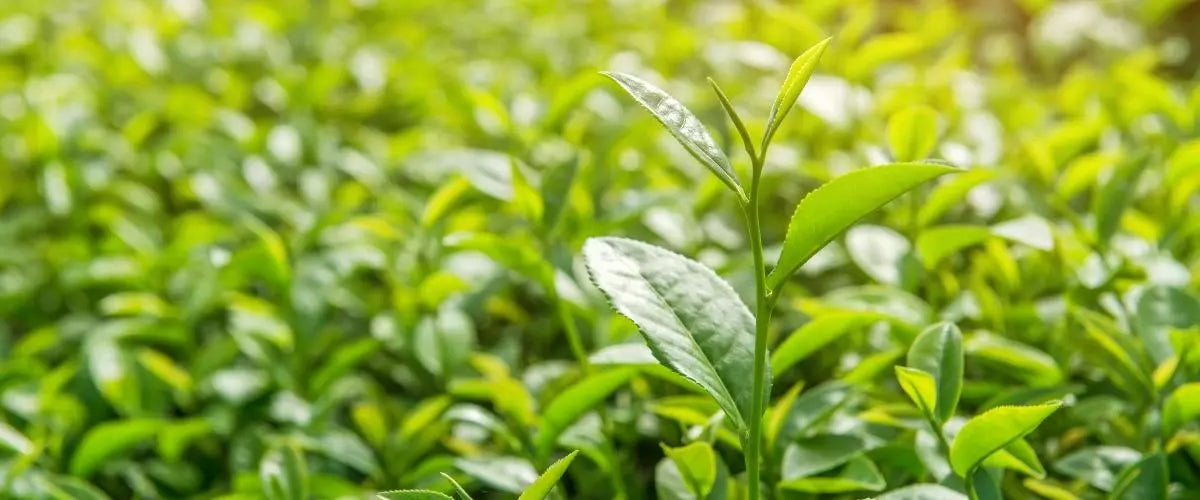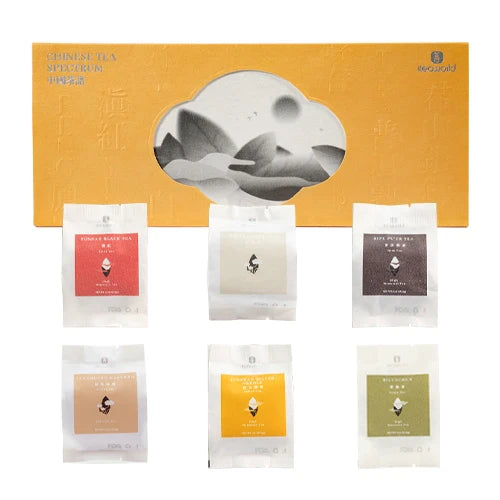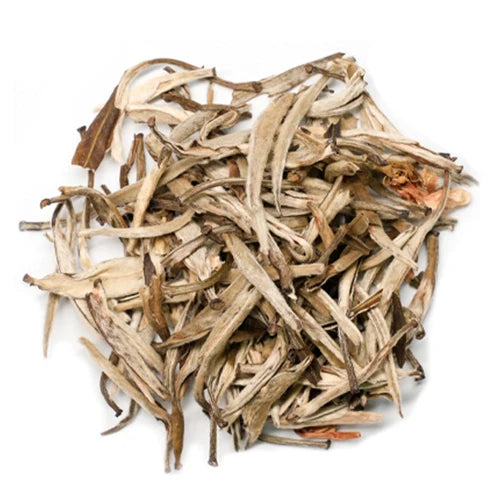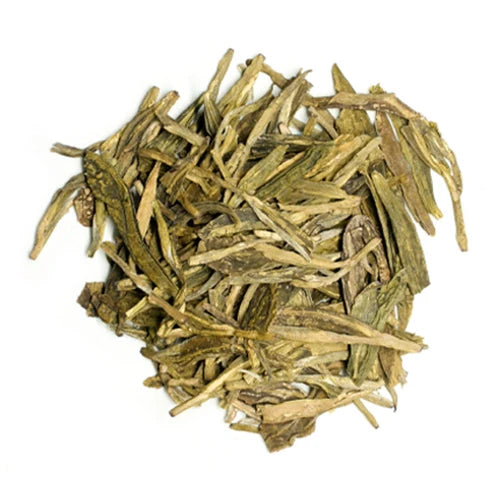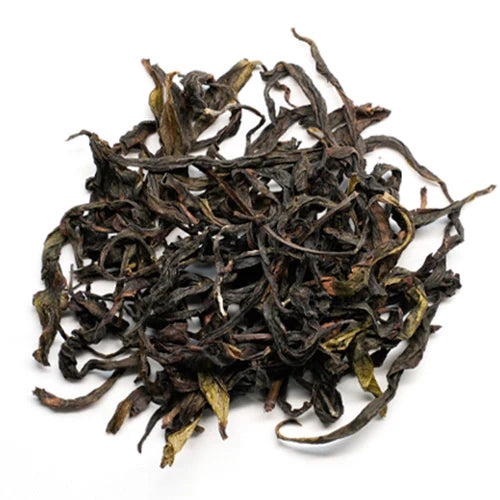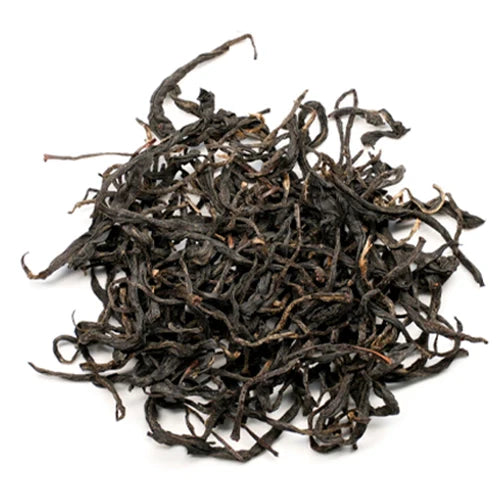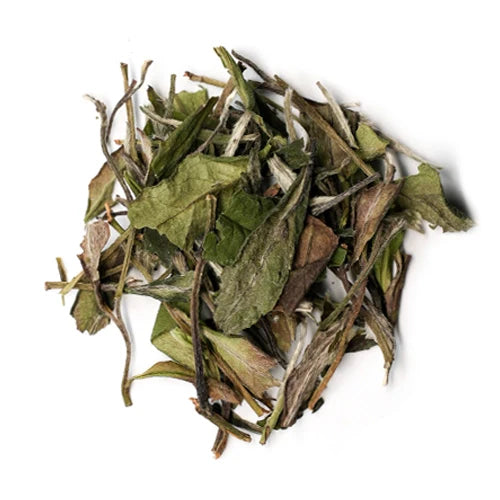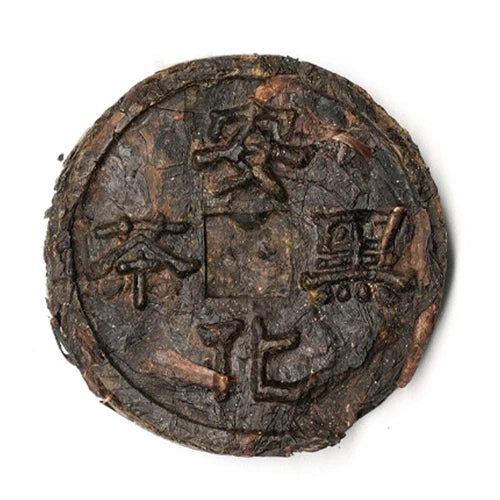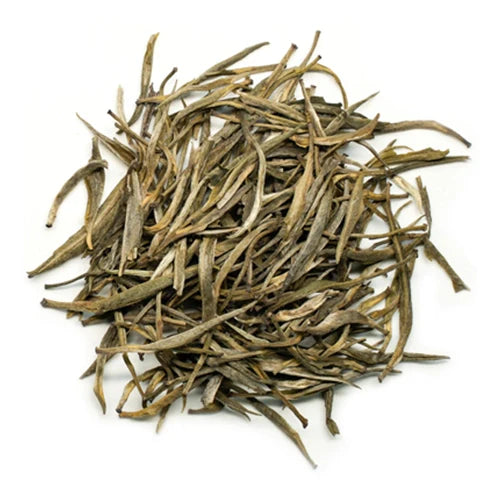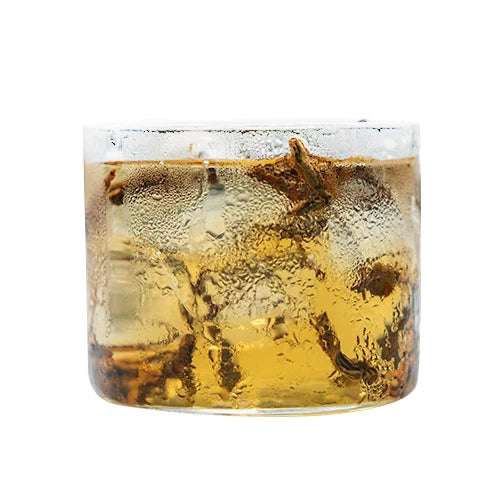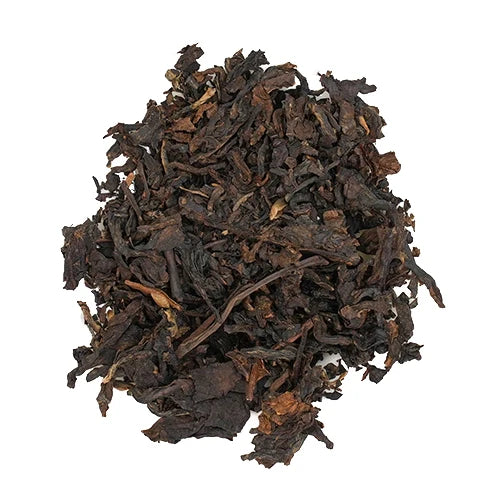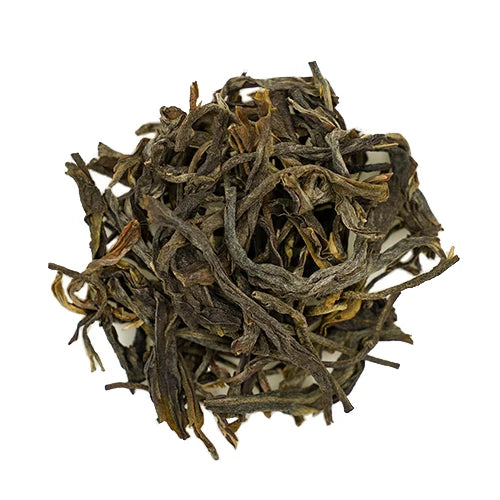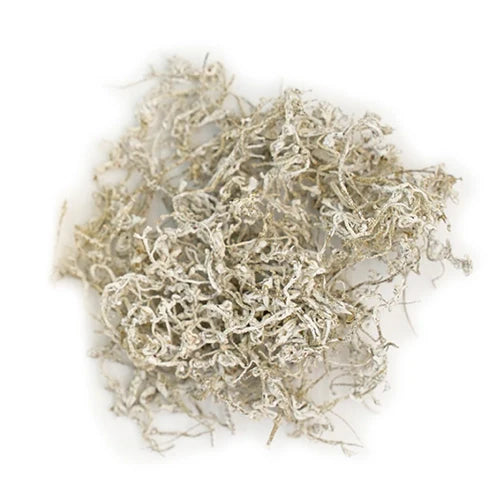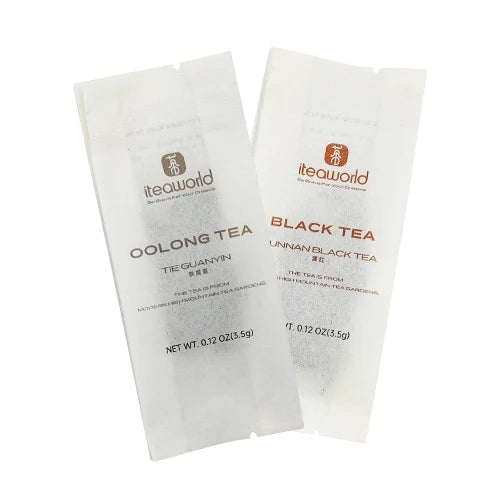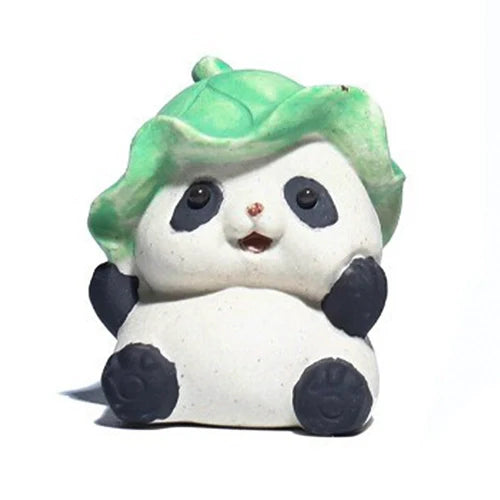Guide
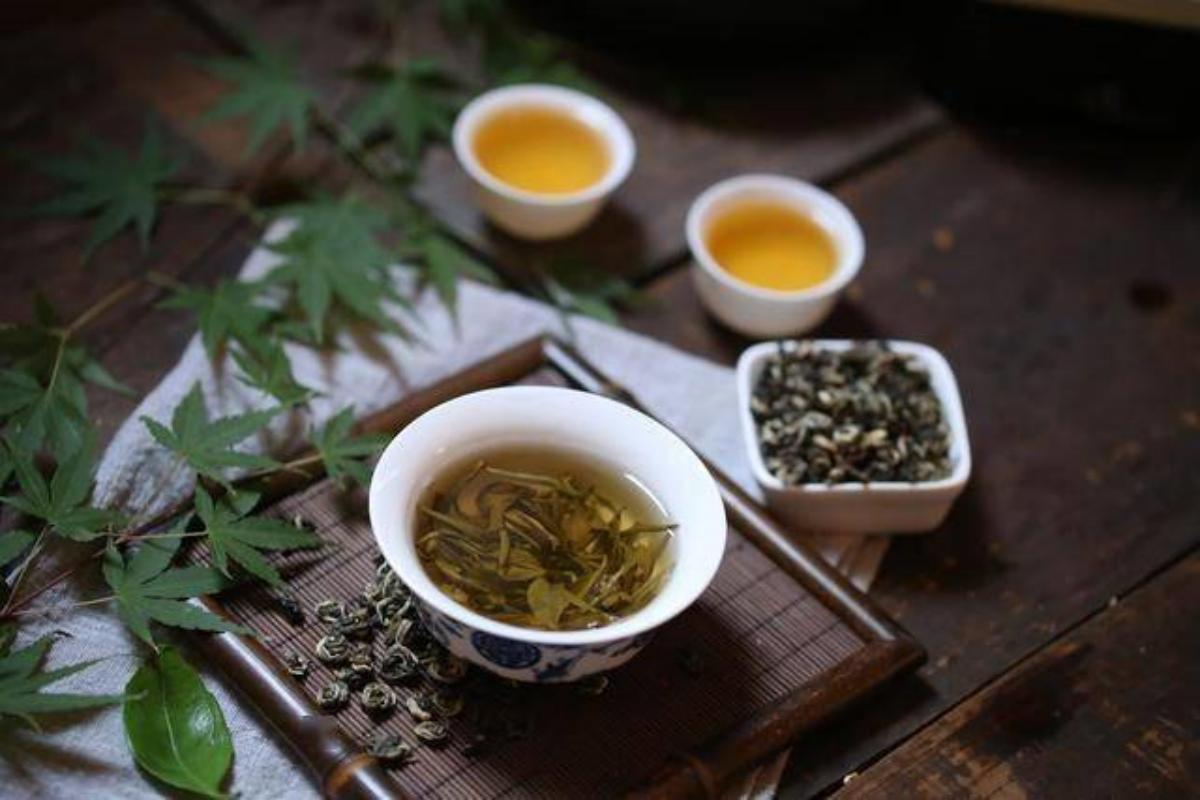
Health Benefits of Dahongpao Tea: Antioxidants and More From This Prized Varietal
I. Introduction
As tea enthusiasts explore the vast world of teas, Dahongpao tea emerges as a distinct and intriguing option. Known for its antioxidants and health benefits, this variety has gained popularity among tea connoisseurs worldwide. In this article, we will explore the origins of Dahongpao tea, its unique flavor profile, and the potential health advantages it offers.
II. Dahongpao Tea's Origin and Authenticity
Dahongpao tea's origin and authenticity are crucial factors that contribute to its exceptional quality and reputation. Let's explore the core producing area of Dahongpao and the significance of obtaining authentic Dahongpao tea.
Savor Tranquility in Every Cup: Explore iTeaworld for the Finest Tea Sampler and Unlock Serenity in Each Brew. >>>
A. The Core Producing Area of Dahongpao
Dahongpao tea finds its roots in the magnificent Wuyi Mountain in Fujian province, China. This region is renowned for its ideal tea-growing conditions, including the unique combination of soil, climate, and elevation. The mineral-rich soil, abundant rainfall, and mist-shrouded mountains create the perfect environment for the growth of tea plants.
The Wuyi Mountain region has been recognized as a UNESCO World Heritage site due to its breathtaking natural beauty and its historical and cultural importance in the world of tea. It is within this awe-inspiring landscape that Dahongpao tea thrives, absorbing the essence of its surroundings.
B. Authenticity and Importance of Obtaining Dahongpao Tea from the Source
Authenticity is paramount when it comes to experiencing the true essence of Dahongpao tea. The demand for this prized tea has led to the emergence of numerous imitations in the market. To ensure you are getting genuine Dahongpao tea, it is essential to source it directly from the core producing area or reliable tea merchants with a reputation for authenticity.
Obtaining Dahongpao tea from the source guarantees that you are getting the tea leaves harvested from the original tea bushes that have been nurtured for generations. The traditional cultivation methods and expertise of the local tea farmers contribute to the unique characteristics and flavor profile of Dahongpao tea.
Furthermore, purchasing directly from the core producing area supports the preservation of the tea's cultural heritage and the livelihood of the local tea communities. It allows you to connect with the rich history and traditions associated with Dahongpao tea, enhancing your overall tea-drinking experience.
When sourcing authentic Dahongpao tea, look for reputable tea vendors who prioritize transparency and provide detailed information about the tea's origin, cultivation, and processing methods. This ensures that you are not only enjoying a genuine cup of Dahongpao tea but also supporting the sustainability and preservation of this revered tea variety.
III. The Unique Yan Flavor of Dahongpao Tea
One of the distinguishing features of Dahongpao tea is its unique "Yan" flavor. Let's delve into the characteristics of this flavor profile and understand how the growing environment contributes to the distinct taste of Dahongpao tea.
Gift the Essence of Tradition: Wrap Well-being in Every Box with iTeaworld's Da Hong Pao Tea Gifts. >>>
A. Wuyi "Yan" Tea and its Characteristics
Dahongpao tea is a representative of Wuyi "Yan" tea, also known as Wuyi rock tea. The term "Yan" refers to the distinctive mineral-rich flavor and aroma that is characteristic of teas grown in the rocky cliffs of the Wuyi Mountain.
The "Yan" flavor of Dahongpao tea is often described as complex, mellow, and lingering. It carries a delightful combination of roasted notes, floral undertones, and a subtle sweetness. The flavor profile is a testament to the unique terroir of the Wuyi Mountain region, where the tea plants grow in the mineral-rich soil and absorb the essence of the surrounding rocks and vegetation.
B. Growing Environment and Rock Crevices' Influence on Dahongpao's "Yan" Flavor
Dahongpao tea trees grow in the narrow crevices of the rocky cliffs, where they are exposed to varying temperatures, sunlight, and moisture levels. The rocky terrain and limited access to nutrients create a challenging environment for the tea plants, forcing them to develop deep root systems in search of sustenance.
It is this struggle for survival and the interaction between the tea plant's roots and the minerals in the rocks that contribute to the unique "Yan" flavor of Dahongpao tea and other loose leaf oolong tea. The rocky environment imparts distinct mineral characteristics to the tea leaves, resulting in a flavor profile that is rich, robust, and often described as having a rocky or mineral undertone.
Additionally, the rocky cliffs provide natural shade and protection for the tea plants, allowing for a slow and steady growth process. This extended growing period allows the leaves to develop complex flavors and aromas, further enhancing the overall taste experience.
The combination of the Wuyi Mountain's unique climate, mineral-rich soil, and the tea plants' interaction with the rocky environment creates the perfect conditions for the development of the sought-after "Yan" flavor in Dahongpao tea.
IV. The Historical Significance of Dahongpao Tea
Legend has it that during the Ming Dynasty, a scholar fell ill while passing through Wuyi Mountain. Monks offered him tea leaves, which miraculously cured him. Grateful for his recovery, the scholar circled the tea bushes, shedding his red robe. These trees were then named "Big Red Robe" in honor of the scholar's gratitude. This historical tale adds a layer of mystique to Dahongpao tea and highlights its rich cultural heritage.
V. Dahongpao Tea's Preparation and Characteristics
The preparation of Dahongpao tea involves a slow roasting process under gentle heat. This meticulous technique contributes to the tea's distinctive flavor and aroma. Dahongpao tea exhibits a sweet aroma with a light smoky scent, making it a delight for the senses.
VI. Health Benefits of Dahongpao Tea
In addition to its captivating flavor and cultural significance, Dahongpao tea offers a range of potential health benefits. Let's explore the antioxidant properties of Dahongpao tea and the various ways it can contribute to overall well-being.
A. Antioxidant Properties and their Importance
Dahongpao tea is rich in antioxidants, which are compounds that help combat harmful free radicals in the body. Free radicals are unstable molecules that can cause oxidative stress and damage to cells, leading to various health issues. By neutralizing free radicals, antioxidants play a crucial role in maintaining cellular health and reducing the risk of chronic diseases.
The high levels of antioxidants found in Dahongpao tea can help protect the body against oxidative stress and support overall well-being. Regular consumption of Dahongpao tea can provide a natural source of antioxidants that contribute to a healthy lifestyle.
B. Potential Health Benefits of Dahongpao Tea
1. Boosting the Immune System:
The antioxidants present in Dahongpao tea help strengthen the immune system, promoting better defense against common infections and diseases. A robust immune system is essential for overall health and well-being.
2. Supporting Heart Health:
Research suggests that the antioxidants in Dahongpao tea may help improve heart health. They can potentially reduce the risk of cardiovascular diseases. Consuming the best loose leaf tea like Dahongpao can provide a rich source of immune-boosting antioxidants.
3. Promoting Digestive Health:
Dahongpao tea is often consumed after meals to aid digestion. It can help soothe the stomach, reduce bloating, and improve overall digestive function. It is also believed to have antimicrobial properties that may help combat harmful bacteria in the digestive system.
4. Enhancing Mental Well-being:
The act of enjoying a cup of Dahongpao tea can be a calming and soothing experience. It can help reduce stress, improve focus, and promote mental clarity. The presence of certain amino acids in the tea leaves may contribute to its relaxing effects.
While Dahongpao tea offers potential health benefits, it is important to remember that individual results may vary, and it should not be considered a substitute for medical advice or treatment. Incorporating Dahongpao tea into a balanced and healthy lifestyle can contribute to overall well-being, but it is always recommended to consult with a healthcare professional for personalized guidance.
VII. Discover iTeaworld: Where Tea Excellence Meets Health
As tea lovers seek out exceptional varieties like Dahongpao, iTeaworld emerges as a brand dedicated to delivering the finest teas to consumers. With a commitment to quality and a passion for preserving the rich heritage of teas, iTeaworld offers a range of meticulously selected teas, including the esteemed Dahongpao tea.Whether you're a tea connoisseur or new to the world of teas, iTeaworld invites you to embark on a journey of taste and wellness. Explore our collection of teas, including the captivating Dahongpao tea, and other loose leaf tea, and experience the harmony of flavors and potential health advantages that our teas have to offer.In a world where tea excellence meets health, iTeaworld is your trusted companion. We invite you to discover the art of tea with us and embrace the moments of tranquility and rejuvenation that come with every sip.
VIII.What kind of people are not suitable to drink Dahongpao?
As a well-known oolong tea, Dahongpao is widely considered to be safe for most people to drink, but there are still some people in special circumstances who may may not be suitable or need to be aware of drinking Dahongpao tea:Pregnant and lactating women: Pregnant and lactating women are advised to drink Dahongpao tea with caution. This is because Dahongpao tea contains high levels of caffeine. Caffeine intake may have an effect on the fetus or baby, so it is recommended to limit the intake of Dahongpao tea.People who are sensitive to caffeine: If you are more sensitive to caffeine, it is recommended to limit your intake of Dahongpao tea. This may cause you to experience some uncomfortable symptoms such as headaches, anxiety, insomnia, etc.Specific Health Problems: Some health problems may be affected by caffeine, such as heart arrhythmia and high blood pressure. If these health problems exist, it is best to consult your doctor before consuming tea.Sleep Problems: If you suffer from frequent insomnia or have sleep problems, then it is highly recommended that you do not drink Dahongpao tea at night. This is because the caffeine in Dahongpao tea is stimulating and energizing, which can aggravate your sleep problems.Digestive Problems: Some people may be sensitive to the acidic stimulation of the tea, which may cause stomach upset or aggravate problems such as acid reflux.
Ⅸ.Caffeine Content of Dahongpao
The caffeine content of each brand of Dahongpao is different, you can refer to the product description for details. Generally speaking, the caffeine content of Dahongpao is in the range of 50-70 mg/235 ml, which is between green tea and black tea.
Conclusion
Dahongpao tea, with its antioxidants and health benefits, stands out as a prized variety in the world of tea. Its unique flavor profile, derived from the rock crevices of the Wuyi Mountains, captures the essence of its origin. The historical significance and cultural heritage associated with Dahongpao tea further add to its allure. As tea enthusiasts continue to explore the vast array of options, Dahongpao tea remains a captivating choice that not only pleases the palate but also offers potential health advantages.
Embrace the world of tea excellence and wellness with iTeaworld, where our commitment to quality and passion for teas meet. Discover our meticulously selected teas, including the revered Dahongpao tea, and immerse yourself in the delightful flavors and potential health benefits that our teas bring.
Let iTeaworld be your trusted companion on your tea journey, as you indulge in moments of tranquility and embrace the harmony of taste and well-being.
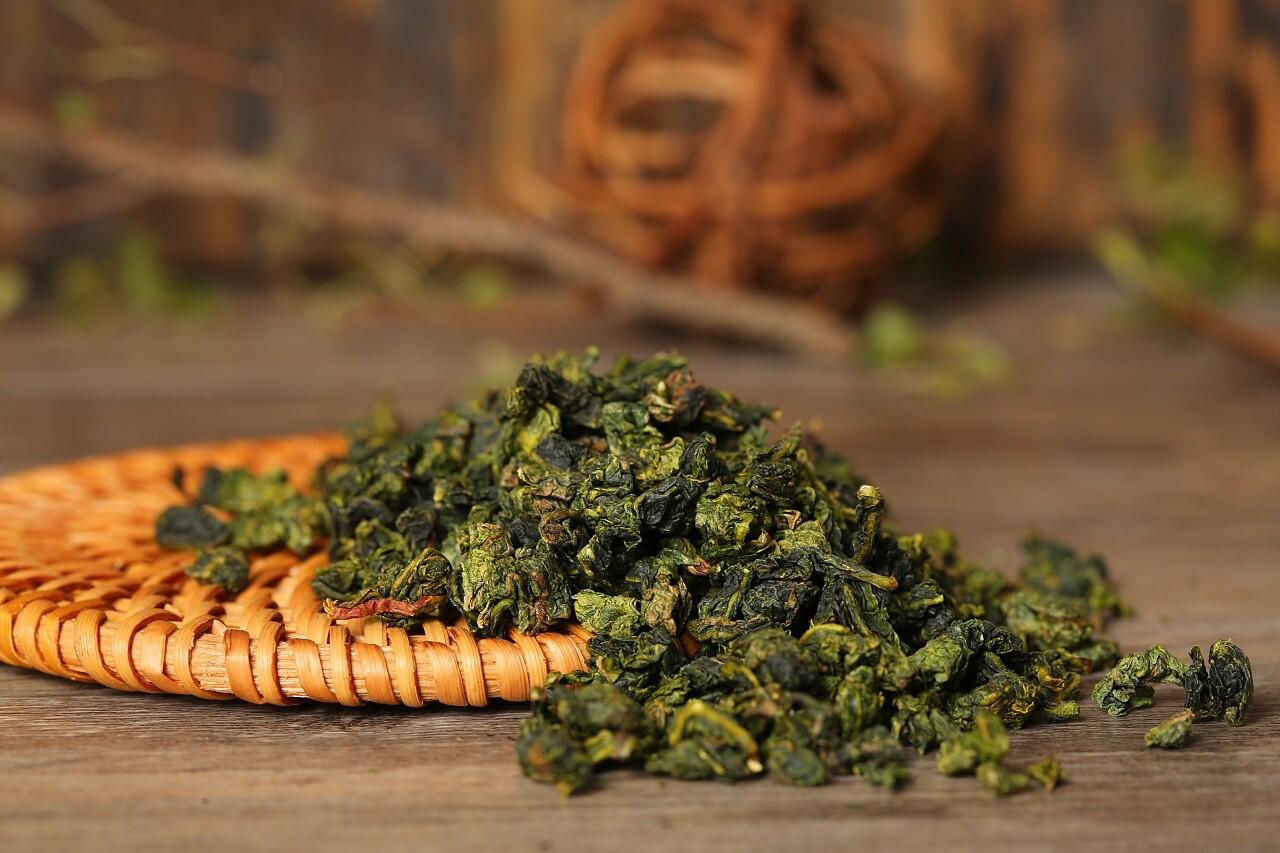
The Health Benefits of TieGuanYin Tea: Nature's Gift of Antioxidants and Flavor
Introduction
Surrounded by mountains and veiled in mist, the picturesque region of Anxi in China is renowned for producing one of the country's most beloved teas - TieGuanYin Tea. With its clean and refreshing aroma, TieGuanYin Tea has captured the hearts and taste buds of tea enthusiasts around the world. Let's embark on a journey to explore the origins, health benefits, flavor profile, and cultural significance of this exceptional tea.
1. Origins and Production
Anxi, nestled amidst breathtaking landscapes, boasts an ideal tea-growing environment. The region experiences an average annual temperature of 15-18℃, a frost-free period of 260-324 days, and an annual rainfall of 1700-1900mm. With a relative humidity above 78%, Anxi provides the perfect conditions for cultivating TieGuanYin Tea. The soil in Anxi is predominantly acidic red soil, with a pH value ranging from 4.5 to 5.6. This deep and organic-rich soil, abundant in mineral substances, imparts a unique flavor to the TieGuanYin tea trees.
TieGuanYin Tea, steeped in history, holds the distinction of being one of China's top ten famous teas. Its origins can be traced back to around 1725, and on May 22, 2023, it was honored with the prestigious "Global Important Agricultural Cultural Heritage" certificate. This recognition showcases its cultural significance and the craftsmanship involved in its production.
Embrace the Essence of Loose Leaf Oolong Tea with iTeaworld! >>>
2. Health Benefits
TieGuanYin Tea not only delights the senses with its flavor and aroma but also offers a wide range of health benefits. Let's explore the various ways in which this exceptional tea can positively impact your well-being.
2.1. Antioxidant Powerhouse:
TieGuanYin Tea is rich in antioxidants, which are essential for combating the harmful effects of free radicals in the body. Free radicals are unstable molecules that can damage cells and contribute to aging, chronic diseases, and oxidative stress. The antioxidants present in TieGuanYin Tea, such as polyphenols and catechins, help neutralize free radicals, reducing the risk of oxidative damage and promoting overall health.
2.2. Digestive Support:
In traditional Chinese medicine, TieGuanYin Tea is believed to have digestive benefits. It is commonly consumed after meals to aid digestion. The tea's properties are thought to help alleviate indigestion, reduce bloating, and promote a healthy digestive system. Regular consumption of TieGuanYin Tea may contribute to better digestion and enhanced gastrointestinal function.
2.3. Cardiovascular Health:
Studies have shown that the antioxidants found in TieGuanYin Tea can have a positive impact on cardiovascular health. The tea may help reduce the risk of heart disease by lowering cholesterol levels, improving blood lipid profiles, and promoting healthy blood pressure. Additionally, TieGuanYin Tea contains flavonoids that support blood vessel health and may help prevent the formation of blood clots.
2.4. Mental Well-being:
TieGuanYin Tea is known for its calming and soothing properties, which can have a positive impact on mental well-being. The tea contains an amino acid called L-theanine, which is believed to promote relaxation, reduce stress and anxiety, and enhance mood. Drinking TieGuanYin Tea can provide a moment of tranquility and help you find balance amidst a hectic day.
2.5. Weight Management:
For those seeking to maintain a healthy weight or support weight loss efforts, TieGuanYin Tea can be a valuable addition to their regimen. The tea's natural compounds, such as catechins and caffeine, have been associated with increased metabolism and fat oxidation. By boosting the body's calorie-burning processes, TieGuanYin Tea may aid in weight management when combined with a balanced diet and regular exercise.
Discover the Timeless Elegance of our Classic Tea Selection, only at iTeaworld! >>>
2.6. Immune System Support:
The immune-boosting properties of TieGuanYin Tea can help strengthen the body's defense mechanisms. The tea's antioxidants, along with other bioactive compounds, can enhance immune function and protect against various illnesses. Regular consumption of TieGuanYin Tea may contribute to a robust immune system, helping to ward off common infections and promoting overall health.
It's important to note that while TieGuanYin Tea offers potential health benefits, individual results may vary. It's always advisable to consult with a healthcare professional for personalized advice, especially if you have any underlying health conditions or are taking medications.
3. Flavor Profile and Aroma
TieGuanYin Tea, often regarded as one of the best loose leaf teas, enthralls tea enthusiasts with its distinctive flavor profile and captivating aroma. Let's delve deeper into the sensory experience offered by this remarkable tea.
3.1. Flavor Profile:
When brewed, TieGuanYin Tea reveals a complex and nuanced flavor that is both refreshing and robust. The taste is characterized by a harmonious balance of sweet, floral, and mineral notes, with subtle hints of fruit and a lingering aftertaste.
The initial sip of TieGuanYin Tea often presents a gentle sweetness that coats the palate, reminiscent of orchids or honey. This delicate sweetness is followed by a refreshing mineral quality, which adds depth to the flavor profile. As the loose leaf tea unfolds on the taste buds, a floral complexity emerges, with notes of lilac, lily, and osmanthus. These floral undertones lend an elegant and fragrant character to the loose leaf tea.
Additionally, TieGuanYin Tea may exhibit subtle fruity notes, such as apricot or peach, which add a touch of natural sweetness. The interplay of these flavors creates a multi-dimensional taste experience that is both invigorating and soothing.
3.2. Aroma:
TieGuanYin Tea enchants with its captivating aroma, often described as orchid-like or reminiscent of blooming flowers. The fragrance exudes a delicate and inviting sweetness that intensifies as the tea is steeped. The aroma of TieGuanYin Tea is a prelude to the sensory journey that awaits, enticing the senses and preparing the palate for the flavors to come.
As the tea leaves unfurl and release their essence, the aroma fills the air, creating an ambiance of tranquility and serenity. The orchid-like fragrance is distinct and alluring, inviting tea lovers to indulge in the sensory pleasures that await them.
Unleash Your Senses with our Exquisite Oolong Tea Selection, exclusively at iTeaworld! >>>
3.3. Texture and Mouthfeel:
Beyond the flavor and aroma, TieGuanYin Tea offers a unique texture and mouthfeel that enhance the overall tea-drinking experience. The tea has a smooth and velvety texture, which coats the tongue and palate, creating a sense of richness. This silky mouthfeel adds a luxurious element to the tea, further elevating the enjoyment of each sip.
The thickness and viscosity of TieGuanYin Tea contribute to its satisfying mouthfeel. The tea glides effortlessly across the palate, delivering its flavors and aromas with elegance and finesse. This characteristic texture enhances the overall sensory experience, making TieGuanYin Tea a delight to savor.
3.4. Variations and Aging:
It's worth noting that within the broad category of TieGuanYin Tea, there are variations in flavor and aroma based on different processing techniques and terroirs. Some variations may lean towards a more floral or fruity profile, while others may exhibit a deeper, roasted character.
Furthermore, TieGuanYin Tea has the potential to age gracefully, much like fine wines. With proper storage and aging, the tea can develop complex flavors and aromas over time. Aged TieGuanYin Tea may exhibit deeper, earthier notes while retaining the tea's inherent elegance. Exploring aged TieGuanYin Tea can be a fascinating journey for Best Loose Leaf Tea enthusiasts seeking a deeper understanding of its flavor evolution.
4. Brewing Techniques and Serving Suggestions
To fully appreciate the nuances of TieGuanYin Tea, it is essential to employ the proper brewing techniques. Whether opting for the traditional gongfu style or a more accessible Western-style brewing, the key lies in finding the right balance of temperature, steeping time, and tea-to-water ratio. Experimentation is encouraged to achieve the desired flavor intensity.
When it comes to serving TieGuanYin Tea, using appropriate tea wares adds an element of elegance to the experience. Delicate tea cups or a traditional gaiwan can enhance the visual appeal and allow the aroma to be savored fully. Pairing TieGuanYin Tea with light snacks or desserts can elevate the tasting experience, as the tea's flavor complements a wide range of culinary delights.
5. Tea Appreciation and Education
Beyond its health benefits and sensory pleasures, TieGuanYin Tea offers a rich cultural heritage and the opportunity for tea appreciation and education. Here are some aspects to explore and appreciate when it comes to this remarkable tea:
5.1. Tea Ceremony:
TieGuanYin Tea is often celebrated through traditional tea ceremonies, which are an integral part of Chinese tea culture. These ceremonies involve precise rituals and techniques for preparing and serving the tea, emphasizing mindfulness and respect for the tea and its heritage. Participating in a TieGuanYin Tea ceremony can deepen your connection with the tea and provide a profound sense of tranquility and harmony.
5.2. Tea Etiquette:
Learning about the proper etiquette associated with TieGuanYin Tea can enhance your tea-drinking experience. From the way you handle the teaware to the manner in which you serve and receive the tea, following tea etiquette demonstrates a reverence for the tea and its cultural significance. Understanding these customs and practicing them can elevate the enjoyment of TieGuanYin Tea and foster a deeper appreciation of tea culture.
5.3. Tea Gardens and Terroir:
Exploring the origins of TieGuanYin Tea can be a fascinating journey. The tea is primarily grown in the Anxi region of Fujian Province, China, where the unique combination of soil, climate, and altitude contributes to its distinctive flavor and aroma. Visiting tea gardens in this region and learning about the cultivation and harvesting processes can provide valuable insights into the tea's production and the dedication of the tea farmers.
5.4. Tea Tasting and Pairing:
Engaging in tea tasting sessions allows you to explore the various nuances and flavors of TieGuanYin Tea. Similar to wine tasting, you can observe the tea's appearance, inhale its aroma, and savor its taste to discern different characteristics. Pairing TieGuanYin Tea with complementary foods, such as light pastries or fresh fruits, can also enhance the overall tea-drinking experience and create delightful flavor combinations.
Indulge in Pure Richness with our Captivating Black Tea Selection, found at iTeaworld! >>>
5.5. Tea Education and History:
Delving into the history and cultural significance of TieGuanYin Tea can deepen your appreciation for this ancient beverage. Learning about its origins, the legends surrounding its discovery, and the influence of Chinese tea culture can provide valuable context and enrich your tea-drinking experience. Books, online resources, and tea workshops are excellent avenues for expanding your knowledge and understanding of TieGuanYin Tea.
5.6. Sustainability and Ethical Sourcing:
In recent years, there has been a growing emphasis on sustainability and ethical sourcing within the tea industry. Understanding the practices of the tea producers, their commitment to fair trade, and their efforts towards environmental sustainability can help you make informed choices as a tea consumer. Supporting tea producers who prioritize these values ensures the long-term viability of TieGuanYin Tea and contributes to a more equitable tea industry.
By immersing yourself in the world of TieGuanYin Tea appreciation and education, you can develop a deeper understanding of this extraordinary tea and its cultural significance. Embracing the rituals, customs, and knowledge surrounding TieGuanYin Tea can transform your tea-drinking experience into a mindful and enriching journey.
6. Cultural Significance and Traditions
TieGuanYin Tea holds a significant place in Chinese tea culture. It is associated with various rituals and ceremonies that have been passed down through generations. The act of brewing and serving TieGuanYin Tea is steeped in tradition and symbolism, representing harmony, respect, and tranquility. Embracing these customs while enjoying a cup of TieGuanYin Tea can deepen one's appreciation for its cultural significance.
Stock Up and Save Big on Summer Tea!
Don't miss out on these incredible summer deals at iTeaworld. With discounts of 20% sitewide + an extra 5% off on Summer Teas, it's the perfect time to stock up on all your favorite loose leaf teas, with total savings up to 25% off.Free Wild Tea Sample with All Orders + First Order Free Shipping Code: FIRSTSHIP (Over $9) Indulge your passion for tea exploration with our new Summer Tea Sampler or expand your collection with our refreshing Green or Cold Brew Tea selections. Whatever your tea tastes, you can enjoy the refreshing and cooling benefits of tea every day while saving money. It's also the ideal opportunity to gift the joy of tea to loved ones this summer.Subscribe For A Chance To Win Ultra-Rare Free Yellow Tea!So browse iTeaworld's extensive selection now and enter the coupon codes at checkout. Tea lovers won't want to miss these unprecedented seasonal savings on Summer Tea!
Conclusion
TieGuanYin Tea, with its nature's antioxidant-rich delight, captivates Best Loose Leaf Tea lovers with its clean and refreshing aroma, distinct flavor profile, and cultural significance. From its origins in the magnificent region of Anxi to its recognition as a global agricultural cultural heritage, TieGuanYin Tea embodies the artistry and craftsmanship of Chinese tea culture. With its potential health benefits and exquisite taste, TieGuanYin Tea continues to be cherished by Best Loose Leaf Tea connoisseurs worldwide.
If you're eager to embark on your own journey into the world of TieGuanYin Tea, look no further than iTeaworld. As a brand that specializes in delivering exceptional tea experiences, iTeaworld offers a range of carefully selected teas, including the authentic and genuine Anxi TieGuanYin Tea. Our commitment to quality and authenticity ensures that you can indulge in the true essence of this remarkable tea.
At iTeaworld, we understand the importance of preserving the traditions and craftsmanship behind TieGuanYin Tea. By sourcing teas from renowned producers and tea estates, we bring you the finest teas that capture the essence of this cultural treasure. Explore our selection and let iTeaworld be your gateway to the world of TieGuanYin Tea.
So, brew a cup of TieGuanYin Tea from iTeaworld, savor its orchid aroma, and indulge in its fresh and strong flavor. Allow yourself to be transported to the misty mountains of Anxi, where nature's gift of antioxidants and flavor awaits. Embrace the heritage, tradition, and sensory delights that TieGuanYin Tea embodies, and experience the excellence that iTeaworld has to offer.
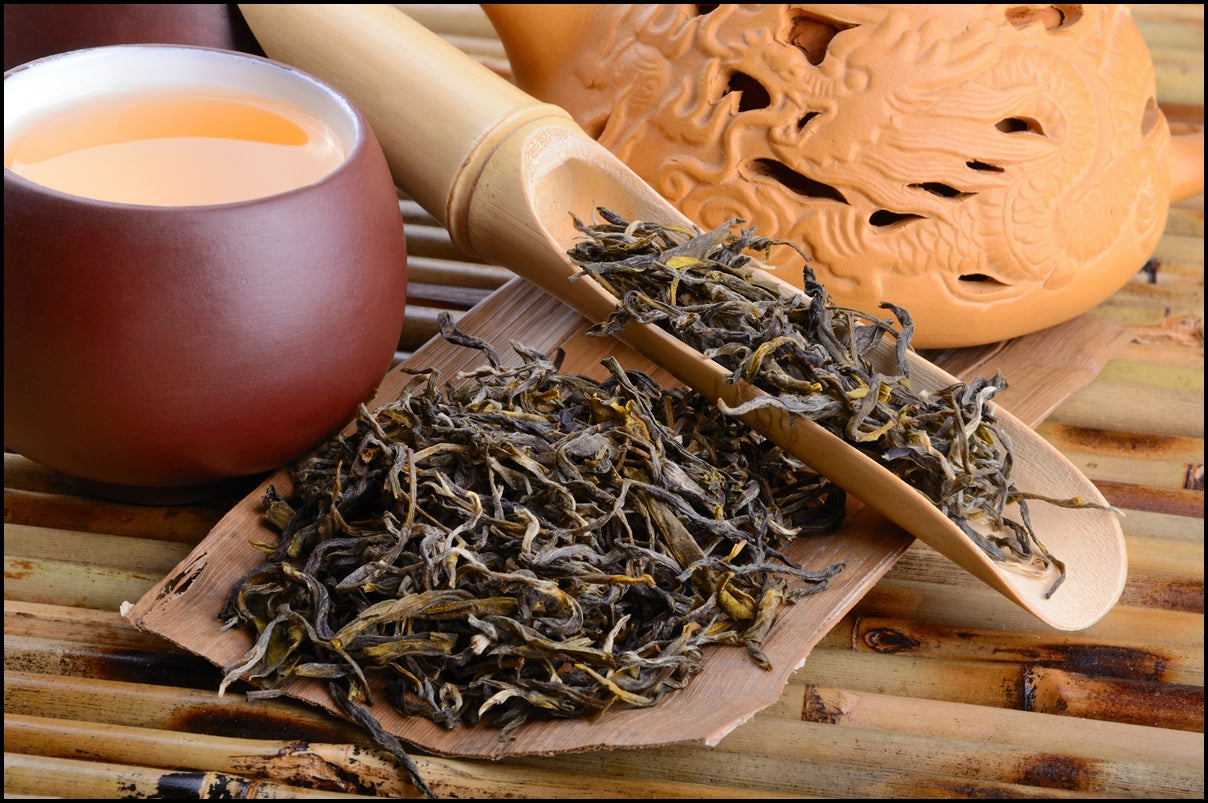
An Introduction to Appreciating Oolong Tea's Complexity
Introduction
Tea, one of the oldest and most beloved beverages in the world, has a rich history steeped in tradition and cultural significance. From the mist-covered mountains of Anxi to the rocky cliffs of Wuyi Mountain and the picturesque landscapes of Guangdong and Fujian, tea-growing regions offer unique terroirs that impart distinct flavors and aromas to their teas. In this article, we invite you to embark on a journey of tea exploration as we delve into the enchanting world of four exceptional tea varieties: TieGuanyin Oolong Tea, Fenghuang Dancong Old Tree Oolong Tea (Mi Lan Xiang Honey Orchid), Dahongpao Oolong Tea (Big Red Robe), and Minnan Narcissus Oolong Tea.
Tea, with its myriad flavors and aromas, provides a sensory experience that captivates tea enthusiasts and novices alike. Each of these teas has its own unique character, influenced not only by the tea plant cultivar but also by the geographical location, climate, altitude, soil composition, and the expertise of tea artisans who carefully process the leaves. Understanding the nuances of these teas can enhance your appreciation for the artistry and craftsmanship behind each cup.
China is renowned for its rich tea culture, steeped in centuries of tradition and craftsmanship. Among the vast array of teas produced in this ancient land, several stand out as the epitome of excellence. From the perfumed elixir of Fenghuang Dancong Old Tree Oolong Tea to the legendary Dahongpao Oolong Tea of Wuyi Mountain, each variety offers a unique and captivating tea experience. In this article, we delve into the world of Chinese tea, focusing on the best loose leaf tea that showcase the artistry and flavors for which China is celebrated. Join us on this journey as we explore the finest teas that grace teacups worldwide.
1. TieGuanyin Oolong Tea: A Delicate Balance of Floral Aromas and Refreshing Taste
1.1. Origins and Significance
TieGuanyin Oolong Tea, also known as Iron Goddess of Mercy, traces its roots to the picturesque Anxi County in Fujian Province, China. This region is renowned for its favorable tea-growing conditions and the expertise of its tea artisans. TieGuanyin has a rich history dating back to the Qing Dynasty and holds a special place in Chinese tea culture.
1.2. Craftsmanship and Flavor Profile
The delicate balance of floral aromas and refreshing taste is a hallmark of TieGuanyin. Expertly plucked from selected cultivars of the Camellia sinensis plant, the tea leaves undergo a meticulous process of withering, oxidation, and roasting. This craftsmanship contributes to the tea's exquisite attributes.
1.3. Aromatic Sensory Experience
Brewing TieGuanyin offers a captivating sensory experience. The aroma unfolds with delightful notes of orchid, lilac, and osmanthus, creating an enchanting bouquet. As you take a sip, the taste reveals mild vegetal undertones, subtle sweetness, and a hint of mineral notes. The tea liquor boasts a beautiful apricot color, enhancing the visual appeal of each cup.
1.4. Versatility in Brewing
TieGuanyin is a versatile tea that can be enjoyed in various brewing styles, allowing for exploration of different flavors and aromas. For a lighter infusion, a shorter steeping time of around 30 seconds to 1 minute is recommended, resulting in a delicate brew. Conversely, a longer steeping time of 2-3 minutes will yield a bolder and more robust flavor.
1.5. Moderate Caffeine Content
With a moderate caffeine content, TieGuanyin is suitable for both morning and afternoon tea sessions. It provides a gentle pick-me-up without causing excessive stimulation. If you prefer to reduce your caffeine intake, a quick rinse of the tea leaves before brewing can help further decrease its caffeine content.
1.6. Choosing TieGuanyin Oolong Tea
When selecting TieGuanyin Oolong Tea, it is advisable to choose teas from reputable producers who adhere to traditional cultivation and processing methods. This ensures the preservation of the tea's authentic flavors and aromas. Exploring different grades of TieGuanyin, such as premium "Competition Grade" or more accessible "Commercial Grade," can offer a range of experiences to suit individual preferences and budgets.
1.7. Indulge in the Enchanting Flavors
Whether you are a seasoned tea connoisseur or a curious beginner, TieGuanyin Oolong Tea invites you to embark on a delightful journey into the world of oolong tea. Its delicate floral aromas, refreshing taste, and versatility in brewing options make it a beloved choice among tea enthusiasts worldwide. So sit back, relax, and savor the enchanting flavors of TieGuanyin Oolong Tea as it transports you to the misty tea gardens of Anxi.
1.8. The 300 Years Old Anxi Tie Guan Yin: A World Cultural Heritage
Amidst the rich tapestry of tea history, one particular variant stands out as a treasure of immense cultural significance—the 300 Years Old Anxi Tie Guan Yin. This extraordinary tea, hailing from the renowned tea-growing region of Anxi County in Fujian Province, China, has been designated as a World Cultural Heritage. Its age-old legacy and exceptional characteristics make it a true gem in the world of tea.
1.9. An Unparalleled Taste and Fragrance
The Anxi Tie Guan Yin captivates tea enthusiasts with its remarkable taste and fragrance. Renowned for its fresh and strong flavor, it delights the palate with a delicate balance of floral aromas and a refreshing aftertaste. The tea's fragrance, reminiscent of the captivating scent of orchids, adds a touch of elegance and sophistication to the overall experience.
1.10. A Feast for the Senses
When brewed, the Anxi Tie Guan Yin reveals its true splendor. Its tea soup color, reminiscent of the luscious hues of apricot, entices the eyes and enhances the visual appeal of each cup. As the aroma unfolds, the air fills with notes of orchid, lilac, and osmanthus, creating a sensory symphony that transports tea lovers to a world of enchantment.
1.11. Medium Caffeine Level for a Balanced Experience
For those seeking a harmonious tea experience, the Anxi Tie Guan Yin offers a moderate caffeine level, making it a perfect choice for both morning and afternoon tea sessions. It provides a gentle pick-me-up without overwhelming the senses, allowing tea enthusiasts to savor its flavors and aromas throughout the day. However, for those who prefer a lower caffeine intake, a quick rinse of the tea leaves prior to brewing can help further reduce its caffeine content.
1.12. Preserving Legacy and Authenticity
To fully appreciate the magnificence of the Anxi Tie Guan Yin, it is essential to choose teas from producers who adhere to traditional cultivation and processing methods. This ensures the preservation of its authentic flavors and aromatic profile, allowing tea enthusiasts to embark on an authentic journey through time.
1.13. A Tea for Every Palate and Budget
The Anxi Tie Guan Yin offers a wide range of options to suit different preferences and budgets. For those seeking the pinnacle of tea excellence, the premium "Competition Grade" teas present a truly exceptional choice. On the other hand, the more accessible "Commercial Grade" teas provide an opportunity for tea lovers to explore the world of Anxi Tie Guan Yin without compromising on quality.
1.14. Embrace the Heritage, Savor the Experience
As you delve into the world of tea, let the Anxi Tie Guan Yin be your guide. With its 300 years of history and the honor of being a World Cultural Heritage, it invites you to indulge in its enchanting flavors and embark on a delightful journey. Whether you are a seasoned tea connoisseur or a curious beginner, this extraordinary tea promises to transport you to the misty tea gardens of Anxi, where time stands still and the essence of tea comes alive. So sit back, relax, and immerse yourself in the timeless allure of the 300 Years Old Anxi Tie Guan Yin, a true testament to the artistry and legacy of tea.
2. Fenghuang Dancong Old Tree Oolong Tea: A Perfumed Elixir
2.1. Origins and Rarity
Fenghuang Dancong Old Tree Oolong Tea, also known as Phoenix Dancong, hails from the Fenghuang Mountain in the Guangdong Province of China. This unique tea variety is produced from ancient tea trees, some of which are several hundred years old. The combination of the specific cultivar and the age of the trees contributes to the tea's exceptional flavor and rarity.
Renowned for its captivating aromas, Fenghuang Dancong exhibits an incredible aromatic complexity. The tea leaves are meticulously hand-picked and processed to preserve their natural fragrance. Each Dancong variety showcases a distinct floral or fruity aroma, reminiscent of orchids, honey, gardenia, osmanthus, or almond blossoms. These fragrances have become the namesakes of the various teas, illustrating the diversity within the Fenghuang Dancong family.
2.2. Aromatic Complexity
One of the most captivating features of Fenghuang Dancong is its incredible aromatic complexity. The tea leaves are carefully hand-picked and processed with great precision to preserve the natural fragrance. Each Dancong variety exhibits a distinct floral or fruity aroma, often resembling the scent of orchids, honey, gardenia, osmanthus, or almond blossoms. The teas are named after these fragrances, showcasing the diversity of aromas within the Fenghuang Dancong family.
Brewing Fenghuang Dancong Old Tree Oolong Tea reveals a multi-layered flavor experience. The tea liquor boasts a smooth texture, balanced astringency, and a lingering sweetness. Its taste is often described as elegant and sophisticated, with notes that range from floral and fruity to honeyed and nutty. The combination of its unique fragrance and nuanced flavors creates a truly indulgent and memorable drinking experience.
2.3. Flavor Experience
Brewing Fenghuang Dancong Old Tree Oolong Tea unveils a multi-layered flavor experience. The tea liquor is known for its smooth texture, balanced astringency, and lingering sweetness. The taste is often described as elegant and sophisticated, with notes that range from floral and fruity to honeyed and nutty. The combination of the unique fragrance and nuanced flavors creates a truly indulgent and memorable drinking experience.
Traditionally, Fenghuang Dancong is enjoyed through the art of Gongfu Cha, a precise Chinese tea ceremony. This method involves multiple short infusions in small teapots or gaiwans, allowing the drinker to fully appreciate the tea's evolving flavors and aromas. Gongfu Cha enhances the complexity of Fenghuang Dancong, making it an ideal way to savor this remarkable tea.
Due to the rarity of ancient tea trees and the meticulous production process, Fenghuang Dancong Old Tree Oolong Tea is produced in limited quantities. It is essential to seek authenticity from reputable tea vendors who can trace the tea's origin and provide information about the specific cultivar and production methods. This ensures a genuine and high-quality tea experience, as counterfeit or lower-quality versions can be found in the market.
Within the family of Fenghuang Dancong, there are numerous distinct varieties, each offering its own unique aroma and flavor profile. Mi Lan Xiang (Honey Orchid Fragrance), Huang Zhi Xiang (Yellow Sprig Fragrance), and Xing Ren Xiang (Almond Fragrance) are among the popular ones. Exploring these different varieties allows tea enthusiasts to discover their personal favorites and appreciate the breadth of aromas and flavors offered by Fenghuang Dancong.
2.4. Art of Gongfu Cha
Fenghuang Dancong is often enjoyed using the traditional Chinese tea ceremony known as Gongfu Cha. This elaborate and precise method of brewing tea involves multiple short infusions in small teapots or gaiwans. Gongfu Cha allows the tea drinker to fully appreciate the tea's evolving flavors and aromas, making it an ideal way to experience the complexity of Fenghuang Dancong.
2.5. Limited Production and Authenticity
Due to the rarity of ancient tea trees and the meticulous production process, Fenghuang Dancong Old Tree Oolong Tea is produced in limited quantities. Authenticity is crucial when seeking this tea, as counterfeit or lower-quality versions can be found in the market. It is advisable to source Fenghuang Dancong from reputable tea vendors who can trace the tea's origin and provide information about the specific cultivar and production methods.
2.6. Exploring Dancong Varieties
Within the family of Fenghuang Dancong, there are numerous distinct varieties, each with its own unique aroma and flavor profile. Some popular ones include Mi Lan Xiang (Honey Orchid Fragrance), Huang Zhi Xiang (Yellow Sprig Fragrance), and Xing Ren Xiang (Almond Fragrance). Exploring these different varieties allows tea enthusiasts to discover their personal favorites and appreciate the breadth of aromas and flavors offered by Fenghuang Dancong.
2.7. An Exquisite Tea Experience
Fenghuang Dancong Old Tree Oolong Tea stands as a testament to the artistry and craftsmanship of Chinese tea production. Its rare and fragrant qualities, combined with the depth and complexity of its flavors, make it a truly exquisite tea experience. Whether savored during a meditative moment or shared with fellow tea lovers, Fenghuang Dancong offers an aromatic elixir that transports the senses and celebrates the rich tea heritage of Guangdong Province.
Fenghuang Dancong Old Tree Oolong Tea stands as a testament to the artistry and craftsmanship of Chinese tea production. Its rare and fragrant qualities, combined with the depth and complexity of its flavors, make it a truly exquisite tea experience. Whether enjoyed during a moment of meditation or shared with fellow tea lovers, Fenghuang Dancong offers an aromatic elixir that transports the senses and celebrates the rich tea heritage of Guangdong Province.
3. Dahongpao Oolong Tea: A Legend of Wuyi Mountain
3.1. Historical Significance and Legendary Origins
Dahongpao Oolong Tea, also known as "Big Red Robe," is a highly regarded oolong tea that originates from the Wuyi Mountain in Fujian Province, China. It holds deep historical and cultural significance and is considered one of the most famous and prestigious teas in China. According to legend, the tea gained its name when it was used to cure an emperor's illness, and the red robe was draped over the tea bushes as a sign of honor.
Thriving in the unique terroir of the Wuyi Mountain, Dahongpao tea bushes encounter challenging conditions that contribute to the tea's complexity. The rocky cliffs, mineral-rich soil, and misty microclimate of the region infuse this tea with a distinct flavor and aroma. It is from this core producing area that Dahongpao tea takes on its most authentic form.
3.2. Unique Terroir of Wuyi Mountain
Dahongpao thrives in the unique terroir of the Wuyi Mountain, which is characterized by its rocky cliffs, mineral-rich soil, and misty microclimate. These natural elements contribute to the distinctive flavor and aroma of the tea. The tea bushes grow in the rocky crevices of the mountainside, encountering challenging conditions that further enhance the tea's complexity.
Dahongpao is renowned for its complex and layered flavor profile. Each brew unveils a symphony of flavors that can include roasted chestnuts, honey, dried fruit, caramel, and a subtle mineral undertone. The tea strikes a perfect balance between sweetness and a slight toastiness, leaving a harmonious and lingering taste that evolves with each infusion.
3.3. Complex Flavor Profile
Dahongpao is renowned for its complex and layered flavor profile. When brewed, it offers a symphony of flavors that can include roasted chestnuts, honey, dried fruit, caramel, and a subtle mineral undertone. The tea strikes a perfect balance between sweetness and a slight toastiness, creating a harmonious and lingering taste that evolves with each infusion.
The unique flavor profile of Dahongpao is achieved through traditional roasting techniques. After careful harvesting, the tea leaves are skillfully roasted under gentle heat, often over charcoal or wood fires. This meticulous process imparts a sweet aroma with a light smoky scent, adding depth and richness to the tea while preserving its flavors and extending its shelf life.
3.4. Traditional Roasting Techniques
The unique flavor profile of Dahongpao is achieved through traditional roasting techniques. After being carefully harvested, the tea leaves are skillfully roasted over charcoal or wood fires. This roasting process imparts a distinct smokiness and depth to the tea, while also helping to preserve its flavors and extend its shelf life.
True Dahongpao is produced in limited quantities due to the scarcity of the original ancient tea bushes. As a result, this prestigious tea is highly sought after and often comes with a higher price tag. Its authenticity and exceptional quality make it a prized possession recognized by tea connoisseurs.
3.5. Limited Production and Prestige
True Dahongpao is produced in very limited quantities, as the original ancient tea bushes from which it is harvested are scarce. The demand for this prestigious tea greatly outweighs the supply, making it highly sought after and often quite expensive. Genuine Dahongpao is recognized by tea connoisseurs for its authenticity and exceptional quality.
Dahongpao holds a special place in Chinese tea culture, often being associated with traditional tea ceremonies and gifting rituals. It symbolizes prestige, elegance, and the appreciation of fine teas. Its long-standing reputation and cultural significance have elevated it to a symbol of Chinese tea heritage.
3.6. Cultural Significance and Tea Heritage
Dahongpao holds a special place in Chinese tea culture and is often associated with traditional tea ceremonies and gifting rituals. It symbolizes prestige, elegance, and the appreciation of fine teas. The tea's long-standing reputation and cultural significance have elevated it to a symbol of Chinese tea heritage.
While the original Dahongpao tea bushes are reserved for special occasions and limited releases, cultivated varieties of Dahongpao are also available. These teas replicate the unique flavor characteristics of the original ancient tea trees through clonal propagation techniques. Exploring these different varieties allows tea enthusiasts to experience the essence of Wuyi Mountain and appreciate the intricate nuances within this legendary tea category.
3.7. Exploring Dahongpao Varieties
While the original Dahongpao tea bushes are reserved for special occasions and limited releases, there are also cultivated varieties of Dahongpao available. These teas are produced using clonal propagation techniques to replicate the unique flavor characteristics of the original ancient tea trees. Exploring different varieties of Dahongpao allows tea enthusiasts to experience the essence of Wuyi Mountain and appreciate the intricate nuances within this legendary tea category.
3.8. A Tea Journey to Remember
Dahongpao Oolong Tea offers tea lovers a memorable journey into the world of Wuyi Mountain and the rich traditions of Chinese tea. Its legendary origins, complex flavor profile, and limited production make it a prized possession among connoisseurs. Savoring a cup of Dahongpao is not only a sensory delight but also a way to connect with centuries of tea heritage and immerse oneself in the legends and stories that surround this esteemed tea.
Embarking on a tea journey with Dahongpao Oolong Tea offers a memorable experience that delves into the world of Wuyi Mountain and the rich traditions of Chinese tea. Its legendary origins, complex flavor profile, and limited production make it a prized possession among connoisseurs. Savoring a cup of Dahongpao is not only a sensory delight but also a way to connect with centuries of tea heritage and immerse oneself in the legends and stories that surround this esteemed tea.
4. Minnan Narcissus Oolong Tea: The Sweet Indulgence of Fujian Province
4.1. Origins and Cultural Significance
Minnan Narcissus Oolong Tea, also known as "Shuixian" or "Water Sprite," originates from the Fujian Province in China. It is particularly celebrated in the Minnan region, which encompasses cities such as Xiamen and Quanzhou. With a history dating back several centuries, Minnan Narcissus Oolong Tea holds a special place in the tea culture of Fujian and is revered for its delightful flavors and aromas.
The latest addition to the Minnan Narcissus Oolong Tea family is a unique variety that has passed Japanese organic food safety tests. This exceptional tea is sourced from tea trees that have been growing for an impressive 60 years. Known for its highly resteepable nature and high sweetness, this tea offers an unparalleled tea-drinking experience.
4.2. Fragrant Floral Aromas
One of the defining characteristics of Minnan Narcissus Oolong Tea is its captivating floral aromas. The tea leaves are carefully processed to preserve the natural fragrance, resulting in a bouquet that evokes the scent of blooming flowers. Notes of gardenia, orchid, and narcissus intertwine to create an intoxicating olfactory experience that enhances the enjoyment of every sip.
With its captivating floral aromas and smooth, velvety texture, Minnan Narcissus Oolong Tea already holds a special place in the hearts of tea lovers. But the addition of this tea, cultivated from 60-year-old tea trees, takes its flavors and aromas to new heights. The tea leaves are carefully processed to preserve their natural fragrance, resulting in a bouquet that evokes the scent of blooming flowers, with notes of gardenia, orchid, and narcissus intertwining to create an intoxicating olfactory experience.
4.3. Sweet and Mellow Flavor Profile
Minnan Narcissus Oolong Tea offers a sweet and mellow taste that lingers on the palate. The tea liquor is known for its smooth and velvety texture, with flavors that range from honey and ripe fruit to hints of roasted nuts. The balanced and harmonious nature of the tea makes it a delightful indulgence for those seeking a gentle and satisfying tea experience.
The sweet and mellow flavor profile of Minnan Narcissus Oolong Tea is further enhanced by this unique variety. The tea liquor offers a delightful balance of honey, ripe fruit, and hints of roasted nuts, leaving a lingering, satisfying taste on the palate. Whether enjoyed through traditional Gongfu brewing or simpler Western-style preparations, this tea promises to deliver a gentle and indulgent tea experience.
4.4. Traditional Processing Techniques
The production of Minnan Narcissus Oolong Tea involves intricate and time-honored processing techniques. After the leaves are plucked, they undergo a meticulous process of withering, tossing, oxidation, and firing. This skilled craftsmanship is crucial in achieving the desired balance of flavors and aromas and contributes to the tea's exceptional quality.
Minnan Narcissus Oolong Tea is well-known for its rich heritage and traditional processing techniques, which contribute to its exceptional quality. The production of this tea involves meticulous steps, including withering, tossing, oxidation, and firing, all performed with skilled craftsmanship. These time-honored techniques ensure that the tea achieves the desired balance of flavors and aromas, allowing tea enthusiasts to savor the true essence of Fujian Province.
4.5. Versatility in Brewing Methods
Minnan Narcissus Oolong Tea is known for its versatility in brewing methods. It can be enjoyed in both traditional Gongfu style and simpler Western-style preparations. Gongfu Cha allows for multiple short infusions, gradually revealing the tea's evolving flavors. Alternatively, Western-style brewing involves longer steeping times, resulting in a more robust and full-bodied cup. Whichever method you choose, Minnan Narcissus Oolong Tea promises a delightful and satisfying tea experience.
In addition to its remarkable flavor and aroma, Minnan Narcissus Oolong Tea is also highly versatile in brewing methods. Whether you prefer the multi-infusion approach of Gongfu Cha or the robustness of Western-style brewing, this tea adapts to your preferences, revealing its evolving flavors with each sip. It's a tea that can be enjoyed in solitude or shared with friends and loved ones, creating memorable moments around a steaming cup.
4.6. Ideal for Dessert Pairings
The natural sweetness and mellow flavors of Minnan Narcissus Oolong Tea make it an excellent choice for pairing with desserts and sweets. The tea's floral undertones complement the richness of cakes, pastries, and even creamy desserts. Whether enjoyed alongside a delicate slice of sponge cake or a decadent chocolate treat, Minnan Narcissus Oolong Tea enriches the overall dessert experience.
Furthermore, the natural sweetness and mellow flavors of Minnan Narcissus Oolong Tea make it an ideal choice for dessert pairings. The floral undertones of the tea complement the richness of cakes, pastries, and creamy desserts, elevating the overall dessert experience. Whether you're enjoying a delicate slice of sponge cake or indulging in a decadent chocolate treat, this tea enriches the flavors and textures, creating a harmonious combination.
4.7. Embracing Fujian Tea Heritage
Minnan Narcissus Oolong Tea offers tea enthusiasts the opportunity to embrace the rich tea heritage of Fujian Province. Its fragrant floral aromas, sweet taste, and versatility in brewing methods make it a beloved choice among tea lovers. With every sip, you can immerse yourself in the cultural traditions and flavors of Minnan, savoring the sweet indulgence that this exquisite oolong tea provides.
Minnan Narcissus Oolong Tea invites tea enthusiasts to embrace the rich tea heritage of Fujian Province. Its fragrant floral aromas, sweet taste, and versatility in brewing methods have made it a beloved choice among tea lovers. And now, with the addition of this exceptional variety sourced from 60-year-old tea trees, the tea-drinking experience reaches new heights of delight and satisfaction.
4.8. Savor the Sweetness of Minnan Narcissus
Indulge in the sweet and fragrant experience of Minnan Narcissus Oolong Tea. Let the delicate floral aromas and mellow flavors transport you to the tea gardens of Fujian Province. Whether enjoyed during a peaceful moment of solitude or shared with friends and loved ones, Minnan Narcissus Oolong Tea offers a delightful and memorable tea drinking experience that embodies the essence of Fujian's tea culture.
Savor the sweetness of Minnan Narcissus Oolong Tea and let the delicate floral aromas and mellow flavors transport you to the tea gardens of Fujian Province. Immerse yourself in the cultural traditions and flavors of Minnan, and experience the sweet indulgence that this exquisite oolong tea provides. Whether enjoyed in moments of solitude or shared with loved ones, Minnan Narcissus Oolong Tea promises an unforgettable journey through the rich tea heritage of Fujian.
5. Comparing the Four Teas:Distinct Flavors and Aromas
While each of these teas offers a unique and captivating experience, let's compare them to help you choose the one that aligns with your preferences:
5.1. TieGuanyin Oolong Tea:
With its refreshing taste and delicate floral aroma, TieGuanyin is an excellent choice for those who enjoy a balanced and aromatic cup of tea. Its moderate caffeine content makes it suitable for both morning and afternoon consumption.
5.2. Fenghuang Dancong Old Tree Oolong Tea:
Known for its captivating perfume-like aroma, Fenghuang Dancong delights the senses with its fragrance. If you appreciate complex and aromatic teas that offer a sensory journey, this tea variety is for you.
5.3. Dahongpao Oolong Tea:
As a representative of Wuyi Rock Tea, Dahongpao boasts a distinct floral aroma and a unique flavor profile. If you're seeking a tea with a story and a deep connection to Chinese tea culture, Dahongpao is an excellent choice.
5.4. Minnan Narcissus Oolong Tea:
Renowned for its sweet indulgence, Minnan Narcissus offers a dense and smooth texture with a satisfyingly sweet taste. If you have a preference for teas with a naturally sweet profile and a thick mouthfeel, this tea variety is worth exploring.
6. Choosing the Right Tea for You: Considerations and Tips
When selecting a tea, it's essential to consider your personal taste preferences, desired aroma, caffeine content, and brewing method. Here are a few tips to help you choose the right tea:
6.1. Flavor Profile:
Consider whether you prefer a more floral, fragrant tea like TieGuanyin or Fenghuang Dancong, or if you lean towards a deeper, roasted flavor like Dahongpao. Minnan Narcissus offers a naturally sweet taste. Experimenting with different flavors will help you discover your preferred tea profile.
6.2. Aroma:
If you enjoy the aromatic experience of tea, look for teas like Fenghuang Dancong and TieGuanyin, which are known for their captivating fragrances. The aroma of the tea can greatly enhance your overall tea-drinking experience.
6.3. Caffeine Content:
Different tea varieties contain varying levels of caffeine. If you're sensitive to caffeine or prefer lower caffeine options, TieGuanyin and Minnan Narcissus are good choices, as they generally have a moderate caffeine content. Dahongpao and Fenghuang Dancong may have slightly higher caffeine levels.
6.4. Brewing Method:
Consider your preferred brewing method. TieGuanyin, Fenghuang Dancong, and Dahongpao are well-suited for traditional brewing methods like gongfu style, which involves multiple short infusions. Minnan Narcissus can also be enjoyed using this method but is equally delightful when brewed in a regular teapot or a Western-style infusion.
By taking into account your taste preferences, aroma preferences, caffeine tolerance, and brewing preferences, you can make an informed decision when selecting one of these exceptional tea varieties. Embark on a tea journey and let your senses guide you to the tea experience that resonates with you the most.
7. Indulge in a World of Exquisite Tea Selections
Are you ready to embark on a journey of tantalizing flavors and captivating aromas? Look no further, as we present to you a selection of four exceptional teas that are sure to elevate your tea-drinking experience to new heights. From the enchanting Fenghuang Dancong Old Tree Oolong Tea to the robust Wild Souchong Black Tea, from the aromatic Minnan Narcissus Oolong Tea to the timeless TieGuanyin Oolong Tea – each of these teas has its own unique allure and promises to delight your senses.
1. Fenghuang Dancong Old Tree Oolong Tea (Mi Lan Xiang Honey Orchid):
Prepare to be transported to the fragrant orchid gardens of Fenghuang. This exquisite tea offers a harmonious blend of honey-like sweetness and floral notes, making it a true masterpiece. With every sip, you'll experience the delicate nuances of this rare and highly sought-after tea.
2. Wild Souchong Black Tea:
For the lovers of bold flavors, this tea is a must-try. Handpicked from ancient tea trees and smoked over pinewood fires, Wild Souchong Black Tea boasts a distinctive smoky aroma and a rich, full-bodied taste. Embrace the rugged charm of this tea as it takes you on a wild adventure with every sip.
3. Minnan Narcissus Oolong Tea:
Allow yourself to be captivated by the captivating allure of Minnan Narcissus Oolong Tea. Grown in the scenic landscapes of southern Fujian, China, this tea entices with its floral fragrance and smooth, mellow taste. Discover the artistry of Minnan Oolong and immerse yourself in its gentle embrace.
4. TieGuanyin Oolong Tea:
Step into the realm of tradition and elegance with TieGuanyin Oolong Tea, the renowned Iron Goddess of Mercy. With its delicate balance of floral aromas and refreshing taste, this tea has charmed tea enthusiasts for centuries. From its enchanting aroma to its apricot-colored liquor, TieGuanyin invites you to experience the beauty of Chinese tea culture.
Each of these teas has been carefully crafted and selected to offer you an exceptional tea-drinking experience. Whether you're a tea connoisseur or a curious beginner, these teas are sure to enthrall and leave a lasting impression. So, why wait? Treat yourself or surprise someone special with these extraordinary teas and let their captivating flavors transport you to a world of tea-infused bliss.
Whether you are seeking a refreshing and delicate TieGuanyin, a perfumed journey with Fenghuang Dancong, a legendary experience with Dahongpao, or a sweet indulgence with Minnan Narcissus, iTeaworld is here to elevate your tea-drinking moments.
Visit our website or explore our collection at select retailers to embark on an extraordinary tea journey with iTeaworld. Let us be your companion in discovering the art of tea and the boundless flavors that nature has to offer.
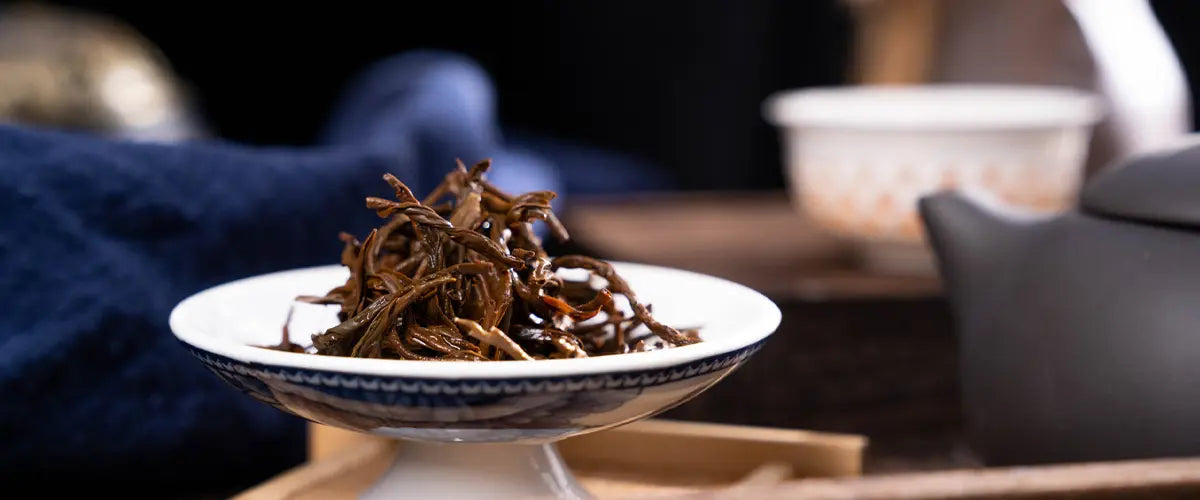
All About Da Hong Pao: Types, Origins, and How to Brew
Also known as Dahongpao, this iconic Wuyi rock tea (Yancha) is famed for its charcoal roast, cliff-grown terroir and layered aroma. This guide explains the name’s legends, why it’s famous, terroir grades (Zhengyan/Banyan/Zhoucha), varieties like Qidan vs. commercial blends, picking, roasting, and craftsmanship—with the original long-form details available below and all videos collected at the end.
Authentic Wuyi origin Charcoal-roasted Cliff-grown terroir
Shop Rock Tea Collection ›
What Is Da Hong Pao (Dahongpao)? Watch related video ↓
Da Hong Pao is the most representative Wuyi rock tea (Yancha) from Fujian, China. It belongs to Chinese oolong tea. Within oolong, northern Fujian Wuyi styles are called rock tea for their cliffside terroir and mineral-tinged taste. It’s long regarded as the “king” of Wuyi teas and among China’s most famous teas.
Why Is It Called “Da Hong Pao” (Big Red Robe)? Watch related video ↓
Long ago, during the Ming Dynasty, a young scholar was hurrying to Beijing to take the all-important imperial exam. As he made his way through the winding paths of the Wuyi Mountains, he suddenly collapsed near Tianxin Temple, stricken with sharp stomach pains.
A kind abbot saw the scholar’s suffering and offered him a cup of tea brewed from the temple’s treasured bushes. After drinking it, the scholar’s pain faded, and his strength returned. With gratitude in his heart, he pressed on to Beijing.
When the results were announced, he had earned the highest honor—first place in the imperial exam, a title that came with a brilliant red robe. Remembering the tea that had saved his life, he journeyed back to Tianxin Temple. Standing before the tea bushes, he removed his robe and draped it over the plants as a gesture of deep respect. From that day forward, the tea became known as “Da Hong Pao”—the Big Red Robe.
Of course, this is not the only tale. Some say the scholar later offered the tea to the emperor himself. The empress, who was gravely ill, drank the tea and soon recovered. The emperor, overjoyed, gifted the scholar a red robe, which he laid over the original tea bushes.
And then there is the lighthearted “monkey-picking” legend, where clever monkeys were said to climb the cliffs and pluck the precious leaves from places humans could not reach.
These stories differ, but they all share a common theme: Da Hong Pao is a tea so extraordinary that people wove legends around it.
Why Is Da Hong Pao So Famous in China? Watch related video ↓
There are two main reasons why Da Hong Pao holds such a legendary status in China:
Its unique natural growing environment, which gives the tea an extraordinary quality.
The extreme rarity of the original “mother trees.”
The mother trees of Da Hong Pao grow in a place called Jiulong Pavilion, near Tianxin Temple in the Wuyi Mountains of Fujian Province. Nestled between sheer rock walls, six ancient tea bushes thrive in this protected niche.
The terrain provides an ideal balance of sunlight and shade. In the morning, the bushes receive direct sunshine, but by midday the surrounding cliffs block the harshest rays—just as ancient tea texts describe: “The finest tea grows in the shade of high mountains, kissed by morning sun.” Modern tea cultivation also echoes this wisdom, often using shade trees to protect leaves from scorching light. Here, the cliffs themselves act as nature’s shade.
Another gift of this location is the mountain stream that flows past the tea bushes. The stream continuously nourishes the soil, carrying minerals from weathered rocks. As the Classic of Tea records: “The best tea grows on weathered rock, medium-grade tea on gravel, and inferior tea on loess.” The mother trees of Da Hong Pao embody this perfect environment, which is why their leaves produce such unmatched quality.
But beyond the environment, scarcity is key. Only six original Da Hong Pao trees exist—three believed to be over 400 years old and the others more than 200 years old. Together, they yield less than a single pound of tea per year. This rarity has made the tea a cultural treasure.
In China, when people speak of the very best Da Hong Pao, they mean the leaves from these mother trees. It is hailed as the “King of Wuyi Rock Tea,” recognized among China’s top ten famous teas, and even presented as a national gift.
Da Hong Pao (Classic)
Type: Commercial/Blended
Aroma & Taste: Incense-like roast, balanced, approachable
Best For: Everyday Yancha, first-time DHP
$19.99 Shop Now
Qidan Da Hong Pao
Type: Purebred (closer lineage)Aroma & Taste: Deeper focus, darker fruit, long finishBest For: Enthusiasts, varietal clarity
$69.99 Shop Qidan ›
Da Hong Pao as a National Gift (1972) Watch related video ↓
One of the most famous diplomatic stories about Da Hong Pao comes from President Nixon’s historic visit to China in 1972.
At the time, Chairman Mao Zedong regarded Da Hong Pao as so rare and precious that he chose it as a national gift. He presented Nixon with a small jar of tea leaves from the original mother trees.
Nixon was puzzled. China was the world’s leading producer of tea, so why was he being given such a tiny amount? Sensing his doubt, Premier Zhou Enlai offered a witty explanation.
He said, “Mr. President, Chairman Mao has already given you half of our country. How can you still not be satisfied?”
Nixon was taken aback and asked what he meant. Zhou then explained: the mother trees of Da Hong Pao were imperial tribute tea for generations, and their total annual yield was only eight taels (about 300 grams). The jar presented to Nixon contained four taels—literally half of the yearly harvest.
The story quickly became legendary, symbolizing both the extraordinary rarity of Da Hong Pao and its place in Chinese cultural diplomacy.
Classification of Da Hong Pao
1. The Mother Trees Watch related video ↓
When people talk about Da Hong Pao, the first distinction to make is between the legendary Mother Tree Da Hong Pao and the later cultivated varieties.
The Mother Trees are the six ancient tea bushes growing on the cliffs of Jiulong Pavilion in the Wuyi Mountains. They are over 300 years old and so rare that almost no one has the chance to taste their leaves. In fact, during the Wuyi Mountain Spring Tea Festival in 2005, just 20 grams of authentic Mother Tree Da Hong Pao sold for more than 200,000 yuan (about $30,000 USD)—a price recorded in official documents.
But rarity comes at a cost. By the early 2000s, the centuries-old trees had grown fragile, and their survival was at risk. In 2006, the Chinese government issued an official ban on harvesting leaves from the Mother Trees in order to protect them.
This means that since 2006, no matter who you are—wealthy or ordinary—you can no longer drink tea made directly from the Mother Trees. What remains are carefully preserved samples in museums and history books, while the reputation of Da Hong Pao continues through cultivated varieties propagated from those original bushes.
2. Qidan Da Hong Pao (Purebred Da Hong Pao)Watch related video ↓
After the original Mother Trees were declared off-limits for harvesting, scientists worked to preserve their lineage. In the 1980s, the Fujian Provincial Tea Research Institute took cuttings from the second and sixth Mother Trees and propagated them through asexual reproduction.
These seedlings, later planted widely in Wuyi Mountain, became known as Qidan. From a varietal perspective, Qidan is the closest genetic match to the Mother Trees, which is why it is often referred to as “purebred Da Hong Pao.”
3. Commercial/Blended DahongpaoWatch related video ↓
As Wuyi rock tea regained popularity in the 1990s, consumer demand for Da Hong Pao far exceeded what Qidan alone could supply. Tea masters responded by creating blended versions—what we now call Commercial Da Hong Pao.
These blends usually combine Qidan with other Wuyi rock teas such as Shui Xian (Narcissus), Rou Gui (Cinnamon), or cultivar “105.” The guiding principle is that the final tea should not taste distinctly like any single ingredient; instead, it should achieve a balanced, harmonious flavor unique to Da Hong Pao.
The best commercial blends often feature Qidan combined with Shui Xian or Rou Gui, sometimes producing distinctive notes such as an osmanthus-like fragrance. Lower-grade versions, however, may contain little or no Qidan at all, relying entirely on other cultivars like Shui Xian, Rou Gui, 105, or even White Cockscomb Tea.
From the perspective of varietal authenticity, commercial Da Hong Pao is the furthest removed from the original Mother Trees. But from a market perspective, it is by far the most widely available form of Da Hong Pao today—and the one most tea drinkers are familiar with.
Type
Origin
Key Features
Availability
Mother Tree Da Hong Pao
Six ancient tea bushes at Jiulong Pavilion, Wuyi Mountain
Over 300–400 years old, imperial tribute tea, legendary status
No longer harvested since 2006 (protected)
Qidan Da Hong Pao (Purebred)
Propagated in the 1980s from cuttings of the 2nd & 6th Mother Trees
Genetically closest to the Mother Trees, stable quality
Limited but available; considered the most authentic
Commercial Da Hong Pao (Blended)
Created in the 1990s using blends of Qidan + other Wuyi rock teas (e.g., Shui Xian, Rou Gui, 105)
Balanced flavor, sometimes osmanthus-like fragrance; furthest from the original in variety
Widely available; the type most people drink today
Picking Standards & Leaf Handling Watch related video ↓
The art of picking Da Hong Pao centers on three goals: strong aroma, rich flavor, and visual beauty. To achieve this, the leaves must be harvested at just the right level of maturity.
Leaf Maturity Stages
Tea leaves go through a clear growth cycle—from tiny buds, to one bud with two leaves, and finally to fully opened leaves. Growers classify the harvest stage as:
Small Open-Face: the new bud has unfolded, but the young leaf is still less than half the size of the next leaf.
Medium Open-Face: the new leaf is more than half but not yet equal in size to the second leaf.
Large Open-Face: the new leaf has grown to the same size as the second leaf.
Among these, small open-face picking is considered the finest. It produces leaves with concentrated aroma and balanced flavor, though it requires the most skill and favorable weather conditions.
Handling Fresh Leaves
Once picked, fresh leaves are extremely delicate. They must be kept in a well-ventilated place to breathe naturally, almost as if they were still on the tree. Using nylon bags or stacking leaves too high can cause them to smother or bruise. When pressure damages the internal water channels of the leaves, moisture release becomes uneven, which lowers tea quality.
Why It Matters
The care taken during harvest—choosing the right maturity and ensuring gentle handling—directly determines the final quality of Da Hong Pao. Every detail, from the timing of picking to the way fresh leaves are stored, preserves the tea’s unique character.
Wuyi Terroir Grades: Zhengyan / Banyan / Zhoucha / Wai Mountain Watch related video ↓
Many tea lovers know the concept of Wuyi Rock Tea.What is the evaluation system of Wuyi Dahongpao?The answer is that according to the growing area of the tea tree, it is categorized into Zheng Yan, Ban Yan, Zhou Cha, and Wai Mountain.Zheng Yan produces the best oolong tea, the others are second best.
Zhengyan: Zheng Yan tea is grown in the Wuyi Mountain scenic area. Core scenic area; deepest “rock rhyme”.
Banyan: Planted on a large scale outside of the Wuyi Mountain Scenic Area, but still within Wuyi Mountain.
Zhoucha: Planted in large areas of the plains around Wuyi Mountain.
Wai Mountain: outside Wuyi.
Compare terroirs: our Rock Tea Collection features core Zhengyan, Zhengyan, Banyan and Zhoucha for side-by-side tasting. Explore ›
Rock Tea Collection
Type:Sampler (Core Zhengyan/Zhengyan/Banyan/Zhoucha)Aroma & Taste: Terroir side-by-side comparisonBest For: Exploration, gifting
$69.99 Explore Set ›
Why Pick in Spring and Bake in Autumn?Watch related video ↓
Da Hong Pao follows a unique production rhythm: picking in April/May, roasting in September/October.
This has to do with the two types of water inside tea leaves:
Free water: evaporates easily during the first roasting.
Bound water: locked inside the leaf cells, harder to remove.
If roasted only once, the inner water remains, leaving a green, raw taste. That’s why Da Hong Pao undergoes two stages of roasting:
First roasting – removes surface moisture.
Second roasting (after ~6 months) – allows internal moisture to redistribute, then removes it completely, while also softening any harsh “fire” notes.
This slow, patient process means that the best Da Hong Pao is not ready until late autumn or the following year. As people in Wuyi Mountain say:
“Every family sells tea from the next year.”
Fresh tea may taste sharp and overly roasted, but after months of resting, it develops the smooth, mellow aroma Da Hong Pao is famous for.
Why Do Some Lots Smell "Baked" or Toasty? Watch related video ↓
Da Hong Pao is processed in two stages; a second charcoal roast (Sep/Oct) reduces moisture (<6%) and refines aroma. Over-high temperature can yield stronger “baked” notes; with rest, fresh “fire” softens.
Craftsmanship of Dahongpao Watch related video ↓
Signature Steps
Withering: two sun / two dry
Make Green (Zuo Qing): shake → rest → hand work (red-edged leaves)
Double fry & roll
Charcoal roasting (often twice, months apart)
Taste & Brewing Quick Guide
Taste Profile
Incense-like aromatics, mineral “rock rhyme”, cocoa/stone-fruit hints, clean roasted finish. Zhengyan often shows the deepest resonance.
Brewing (Gongfu / Mug)
Gongfu: 6–8 g / 100 ml, 95–100 °C, 8–15 s infusions; many steeps.
Mug/Teapot: 2–3 g / 250–300 ml, 95 °C, 2–3 min; re-steep 2–3×.
Tip: If freshly roasted, decant and air briefly to let “fire” soften.
Niche Yancha picks: consider a bundle featuring Rougui (cinnamon spice), Shuixian (orchid/mineral), and rarer cultivars for deeper exploration. See bundle ›
Ready to taste authentic Wuyi rock tea?
Compare terroirs with our Rock Tea Collection, or go straight for Qidan or a classic Da Hong Pao.
Shop Rock Tea Collection ›
Back to top ↑
Da Hong Pao – Video Library
Explore all related clips in one place. Tap a thumbnail to play.
What’s your tea today? Dahongpao
Why is it called Dahongpao?
Why is it well-known?
Mao & Nixon anecdote
Mother-tree Dahongpao
Qidan (purebred)
Commercial/Blended DHP
Picking standards
Origin & terroir
Baked/toasty notes
Pick & bake timing
Craftsmanship (process)
Enjoy authentic Da Hong Pao at home
Shop Now
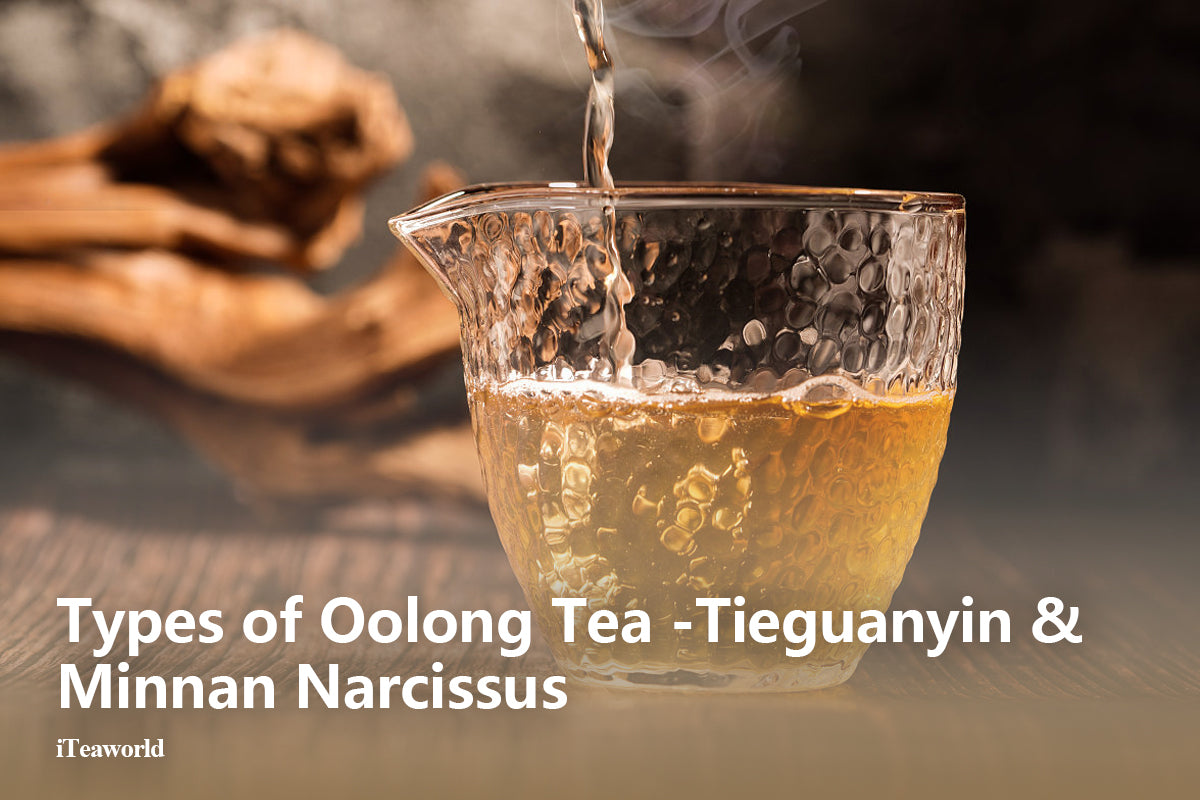
Tieguanyin & Minnan Narcissus Detailed Guide
There are two typical representative teas of Minnan Oolong, let's compare these two teas today!
1. Tieguanyin
2. Minnan Narcissus
In China, there are three major production areas of Oolong tea
Northern Fujian Oolong
Minnan Oolong
Guangdong Oolong
Taiwan Oolong
Today we mainly talk about Minnan oolong.Among them, Tieguanyin is the most typical representative of Minnan Oolong and is also the most widely recognized.Apart from Tieguanyin, Minnan Narcissus, Yongchun fo shou, and Zhangping Shui Xian are also well-known varieties of Minnan Oolong.Why did iTeaworld choose Tieguanyin and Minnan Narcissus?It is because they are both well-known teas with good quality and have a long history.
Why is this tea called Tieguanyin?
At the beginning of the 18th century, there was a local tea farmer in Anxi who believed in Buddhism, and he made tea offerings to Guan Shiyin Bodhisattva every dayOnce when he went out to inspect the tea plantation, he found a tree in a cave. The leaves were large and shiny, it was a very special leaf, so he took it home to process it into oolong teaAfter making it, he found that the flavor of oolong tea made from this leaf was very different.So he transplanted the tea tree back and propagated it with plugs.The tea grower thought that this tea was given to him by the Bodhisattva Guanshiyin, and because the color of the tea is very similar to the color of iron, which is "tie" in Chinese, it was named tieguanyin tea.
Types of Tieguanyin
There are two types of Tieguanyin tea, one is the traditional charcoal roasted Tieguanyin tea and the other is the modern craft Tieguanyin tea.Traditional Tieguanyin tea: sandy green in color.Modern Tieguanyin tea: bright green color in appearanceModern Tieguanyin has a similar taste to green tea.iTeaworld chose this Anxi Tieguanyin tea for two main reasonsFirst, it is from the authentic Anxi High Mountain tea plantation.Secondly, it is a traditional charcoal-roasted tea.This allows people to experience the different charms of traditional Chinese craftsmanship.
How to brew Tieguanyin tea?
Tieguanyin is a low-fermented tea, so more attention should be paid to its aromaTherefore, it is best to brew in a wide-mouth bowl, so that the tea leaves can fully unfold in the tea brothIt is also recommended to choose the "high brewing" method, that is, pouring hot water into the tea cups from a higher distance, to better stimulate the aroma of Tieguanyin.
About "Guanyinyun" of Tieguanyin tea
About "Yun"
Many of our famous Chinese teas have the word "yun".For example, Tieguanyin tea has "Guanyin Yun", Minbei Oolong tea has "Smoke Yun", and Monocotyledon tea has "Alpine Yun".Tea with "yun" is beyond ordinary tea.Tea that can be called "yun" can not only give you material enjoyment but also bring spiritual pursuit.It can make people happy
About "Guanyin Yun"
"Guanyin Yun" is a unique quality characteristic of Tieguanyin tea. It is a bit mysterious to say, what will change with the different feelings of the tea tasters
In my opinion, I understand that "Guanyin yun" refers to the throat after drinking arrogant, there is a kind of alpine tea unique sense of coolness! And the sweetness of Tieguanyin will make you feel the "yun" of the unusual!Ordinary tea can seldom give you such a rich and multi-layered feeling! Only the core production area and the superior traditional craftsmanship can produce the "Guanyin yun" Tieguanyin tea.
Differences between Minnan Narcissus and Tie Guanyin
The core difference lies in the difference in the degree of oxidation, i.e. the different processing techniques, with Tieguanyin having a much lower degree of oxidation.Oolong tea is a semi-fermented tea, known in Western terminology as oxidized tea, with a degree of oxidation between completely unoxidized green tea and fully oxidized black teaDifferent varieties of tea and different origins of tea masters may allow the tea to oxidize to different degrees again during processing.Tieguanyin is a very low-oxidized tea, and tea masters feel that a low level of oxidation can be more conducive to the development of its characteristics and advantagesMinnan Narcissus has no advantage over Tieguanyin in terms of aroma, but its taste is more mellow and rich.Therefore, the tea master will make it oxidized to a higher degree, to oxidize the tea polyphenols into theaflavin or thearubigin, which further enhances the mellowness of the tea broth.
Characteristics of Minnan Narcissus
The characteristics of Minnan Narcissus tea are weak aroma, but rich in water and mellow taste.Minnan Narcissus tea is a semi-tree tea with a trunk.iTeaworld's Minnan Narcissus tea is selected from Yongchun Tea Factory.Yongchun Tea Factory is a decades-old tea factory founded by the Indonesian Chinese.The raw material for our Minnan Narcissus tea comes from tea trees planted in the 1950s and 1960s.It's basically 70, 80 years old now or more
Why did iTeaworld choose this Minnan Narcissus?
Because older tea trees are sweeter and the tea broth is more mellow.And the production process of the old tea factory is more traditionalIt allows people to experience the real traditional Minnan Narcissus tea.
What is the aroma of Minnan Narcissus tea?
There are two kinds of aromas of Minnan Narcissus tea.One kind of aroma is a variety of aromas (orchid)The other is the aroma of the dancong aromas, which is the aroma that will appear only when the tree is older, similar to the aroma of rice dumpling leaves.Compared with the common Minnan Narcissus, iTeaworld's Minnan Narcissus has unique dancong aromas.And due to the old age of the trees, this tea has a mellow flavor and good sweetness!There is a sweetness in your throat when you drink it, and it will be sweet back, which is unique to old tree tea.
Comparison of brewing methods between Tieguanyin and Minnan Narcissus tea
Tea set:
Minnan Narcissus tea should be brewed in purple sand pots or thick teacups.Tieguanyin tea is light and elegant, suitable for thin-lid teacups, and better able to set off its aroma
Water temperature:
Tieguanyin's oxidization degree is relatively low, the brewing water temperature can be a little lower.For Minnan Narcissus, the water temperature must be high!
Tea water ratio:
Tieguanyin's tea-to-water ratio is 1:30The ratio of tea to water for Minnan Narcissus is 1:35.
Brewing time:
Tieguanyin's brewing time is shorter, and Minnan Narcissus's brewing time is longer.The brewing time for Minnan Narcissus can be 10 seconds, and Tieguanyin can be 8 or 7 seconds.
Drinking Time Suggestion
I like to drink Tieguanyin in the summer or in the morning, it makes me feel more happy and elegant.As for Minnan Narcissus, I would drink this tea in winter or in the eveningOld tree tea is very strong and mellow, and very calm after drinking it
Preservation Method
The preservation of oolong tea is the same as black tea and green tea, it must be sealed.Storage environment temperature should be below 25 degrees and humidity below 65 degrees.No odor, no light, no strong light, such an environment will be betterAs Tieguanyin has a low level of oxidation, after one year or 36 months, its taste will deteriorate with oxidation and become very unpleasant to drink.Minnan Narcissus is made by the traditional oolong tea process, with deeper fermentation, and tastes better when stored for 5 or 10 yearsI have seen many people on the internet say that old oolong tea tastes good, but the premise is that the process needs to be traditional oolong tea processThe deeper the fermentation, the longer the tea is stored, the better the flavor.
The tea-drinking atmosphere and the pursuit of tea aesthetics in China are very different from other countries.I think everyone should not be fixed in a certain area, but try more and compare more.So that the understanding of tea will be clearer.
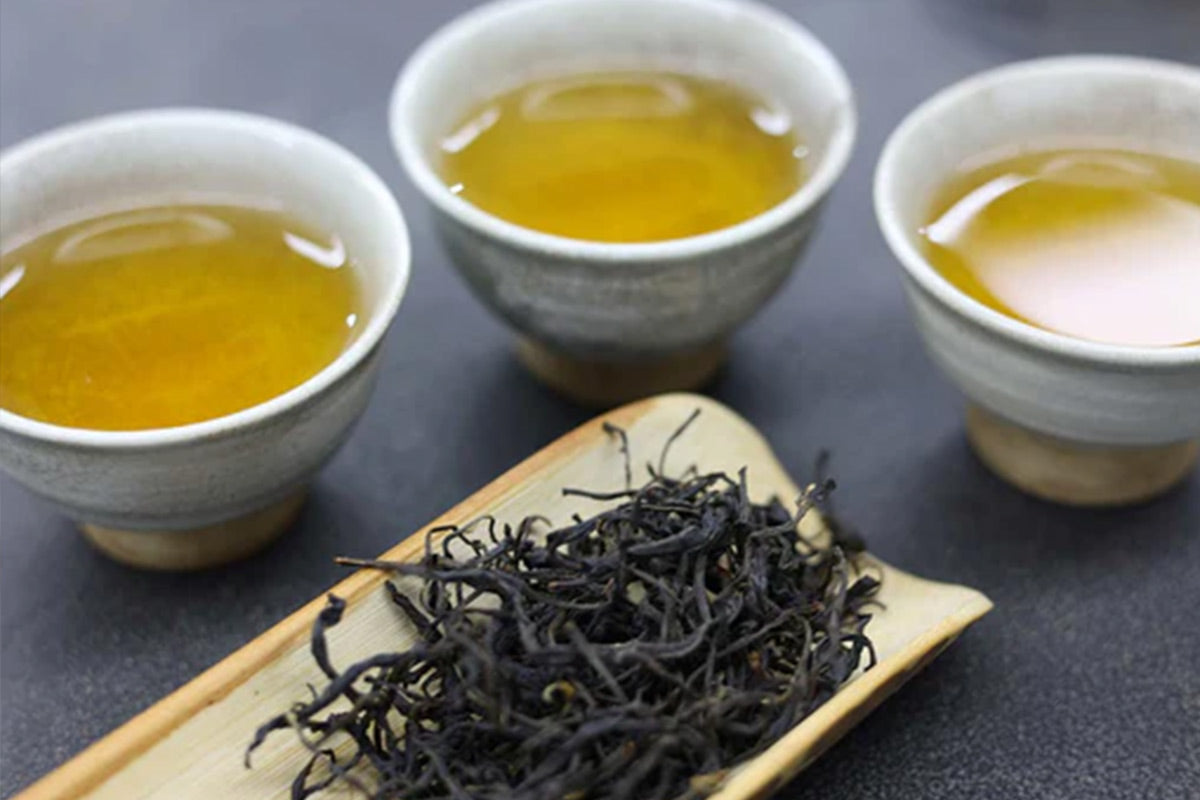
Oolong Tea Benefits | Do You Really Know About Oolong tea?
Oolong tea is a unique type of organic tea in China, and is highly sought after for its unique taste and health benefits.
Oolong tea offers the advantages of both green tea and black tea, with the mellowness of black tea but stronger astringency than black tea, and the freshness of green tea but without the astringency of green tea.
Read on to discover the benefits of drinking oolong tea!
Benefits of Oolong Tea
Facilitate Weight Loss
Refreshing and Relaxing
Antibacterial and Anti-inflammatory
Protect Teeth
Benefits of Oolong Tea
Oolong tea contains a variety of nutrients, including tea polyphenols, plant alkaloids, proteins, amino acids, vitamins, pectin, organic acids, lipopolysaccharides, sugars, enzymes, pigments, etc. Regular consumption of oolong tea has specific benefits for the human body.
Facilitate Weight Loss
If you want to lose weight, try drinking Loose Leaf Oolong Tea. Oolong tea has the effect of dissolving fat. Because the main component in tea - tannic acid, has a close relationship with fat metabolism. Oolong tea can lower blood cholesterol levels. Compared with black tea and green tea, oolong tea can not only stimulate the activity of pancreatic lipolytic enzymes, reduce the absorption of sugar and fatty food, but also accelerate the increase of body heat, promote fat burning, and reduce the accumulation of abdominal fat.
Refreshing and Relaxing
If you are tired of drinking coffee, drinking oolong tea is also a good choice for energy in the morning. The caffeine in oolong tea can promote the excitement of the central nervous system, can enhance the excitement process of the cerebral cortex, and then play a refreshing role in eliminating fatigue.
Antibacterial and Anti-inflammatory
Oolong tea contains a large amount of tea polyphenols, which can effectively inhibit the reproduction of pathogenic bacteria and viruses, and have antibacterial and anti-inflammatory effects.
Protect Teeth
The effect you can't think of is that oolong tea can also protect teeth! Oolong tea has a high fluorine content, of which 10 mg to 15 mg per 100 grams of dry tea, a large part of which is water-soluble. Drinking oolong tea can increase the intake of fluorine, so as to achieve the best tooth protection.
Recommended Oolong Tea
iTeaworld offers a wide range of oolong teas of good quality at the right price.For example, Tie Guanyin, Minnan Narcissus, Dahongpao, and Fenghuang Dancong.These are all well-known Chinese Oolong teas.In addition to this, iTeaworld also offers an Oolong Tea Sampler.It contains the four teas mentioned above. You can experience them all at once!
Tieguanyin
Tieguanyin--This is an oolong tea famous for its light flavor. The tea leaves are curlyWhen you take the first sip you will feel a light creamy texture. There is no astringency at all and the taste is smooth and freshGreat for those who are trying oolong tea for the first timeMinnan NarcissusMinnan Shuixian--This is one of iTeaworld's highly acclaimed teas. The floral natural sweetness is perfectly balanced and the rich roasted flavor excites the taste buds. This is a perfect morning cup of tea!Fenghuang DancongEvery tea lover will be satisfied with Fenghuang Dancong. There are no bad reviews!Very strong peach flavor hits the nose. The taste is delicate and smooth with a sweet flavorThis is a great milanxiang Fenghuang Dancong!DahongpaoDahongpao is a very well known oolong tea from China. It has a dense, creamy texture and a sweet, mineral taste that will give you a rocky tea experienceThe above four oolong loose leaf teas are all selected by iTeaworld, synthesizing the taste evaluations and tea quality judgments from several 20+ years old tea lovers. Perfect for tea lovers who want to savor a variety of Chinese Oolong teas at once. If you are interested in Oolong tea, why don't you try them out and experience the special taste of Oolong tea and its efficacy together!

Which Oolong Teas Are Most Popular in China?
1. Minnan Oolong Tea
2. Minbei Oolong Tea
3. Guangdong Oolong Tea
4. Taiwan Oolong Tea
Oolong tea is famous all over the world, and China is the place of origin of Oolong tea. In China, Oolong tea is mainly produced in Fujian Province (Minbei and Minnan), Guangdong Province, and Taiwan Province. In addition, Sichuan Province and Hunan Province also have a small amount of oolong tea production.According to the place of origin, oolong tea can be divided into four types of oolong tea.The four types are Minnan Oolong Tea, Minbei Oolong Tea, Guangdong Oolong Tea, and Taiwan Oolong Tea.Let's explore the difference between these four types of Oolong Tea and the loose leaf Oolong Tea provided by iTeaworld.
1. Minnan Oolong Tea
According to the degree of Zuoqing, Fujian oolong tea is divided into Minnan oolong tea and mini oolong tea. Minnan oolong tea is lightly sun-dried, heavily kneaded twisted, and lightly fermented. Consequently, Minnan oolong tea has a feature of green leaves with red edges. Minnan oolong tea has an obvious flower fragrance and a clean and mellow flavor. The tea soup of Minnan oolong tea is gold. Minnan oolong tea is mainly known for its fragrance. Among various types of Minnan oolong tea, Anxi Tie Guanyin has the most elegant fragrance. The main types of Minnan oolong tea are Anxi Tie Guanyin, Huangjingui, Yongchun Buddha hand, and Minnan Narcissus.
The Tieguanyin offered by iTeaworld is from the core production area, Anxi. It is a good Tieguanyin. With a creamy and floral aroma, it has a mild, smooth flavor without any bitterness and a buttery feel in the mouth.Besides, iTeaworld also offers minnan narcissus Oolong Tea, which is an oolong tea with a perfect balance of floral and natural sweetness, with a pleasant and delicate taste. The first sip reveals a light charcoal roasted flavor with a long-lasting floral note that lingers on the finish.
2. Minbei Oolong Tea
Minbei Oolong Tea is heavily sun-dried, heavily kneaded twisted, and heavily fermented. The fragrance of Minbei Oolong belongs to a ripe fragrance. The tea soup is bright orange and the flavor is a mellow and sweet aftertaste. After being brewed, the tea leaves are 30% red and 70% green, with clear red edges. Wuyi Yan tea is a category of Minbei oolong tea. The tea trees of Wuyi Yan tea grow on the rock and soil layers in Wuyishan City. Thus, Wuyi Yan tea has a special feature of Yan flavor. Wuyi Yan tea is rich in fragrance. The main types of Wuyi Yan tea are Minbei Narcissus, Wuyi Narcissus, and Wuyi Cassia.
The Minbei oolong tea offered by iTeaworld is the famous Dahongpao with a distinct roasted aroma and a flavor similar to that of a peach's drupe. This is great Wuyi tea.
3. Guangdong Oolong Tea
Guangdong oolong tea is produced on high mountains over 1000 meters in eastern Guangdong Province. Guangdong oolong tea is heavily sun-dried, heavily kneaded twisted, and heavily fermented. The tea soup of Guangdong
The Guangdong Oolong tea offered by iTeaworld is fenghuang dancong, a tea that has been reviewed by most tea lovers. When you open the package, the incredibly rich peach aroma hits you. This is a milanxiang single fir, and when you finish the tea, it leaves a long-lasting honey aftertaste on your mouth, which tends to evoke the nectar of blooming orchids.
4. Taiwan Oolong Tea
Taiwan oolong tea originated in Fujian Province. After being transported to Taiwan, the tea-making techniques of Fujian oolong tea changed and gradually developed into Taiwan oolong tea techniques. The typical types of Taiwanese oolong tea are Tung-ting oolong tea, Jinxuan oolong tea, and honey-scented oolong tea (oriental beauty).
If you are interested in Oolong tea, then you can start by trying the Oolong Tea Selection, which allows you to taste four different loose leaf Oolong tea at once at a low cost. This is also perfect as a gift for someone.Oolong teas from different regions, with their own regional characteristics, are a wonderful gift from nature. iTeaworld has selected three of these regional classic oolong teas, which allow you to experience a wide range of flavors in a single box, whether you like fresh floral notes, distinctive rocky notes, or rich fruity notes!
Some text and pictures are from other sources. If there is any infringement, please contact us.





